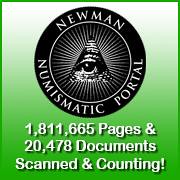
About UsThe Numismatic Bibliomania Society is a non-profit organization devoted to the study and enjoyment of numismatic literature. For more information please see our web site at coinbooks.org SubscriptionsThose wishing to become new E-Sylum subscribers (or wishing to Unsubscribe) can go to the following web page link MembershipThere is a membership application available on the web site Membership Application To join, print the application and return it with your check to the address printed on the application. Print/Digital membership is $40 to addresses in the U.S., and $60 elsewhere. A digital-only membership is available for $25. For those without web access, write to: Terry White, Treasurer AsylumFor Asylum mailing address changes and other membership questions, contact Terry at this email address: terrywhite5475@yahoo.com SubmissionsTo submit items for publication in The E-Sylum, write to the Editor at this address: whomren@gmail.com BUY THE BOOK BEFORE THE COINSale Calendar
|
- WAYNE'S WORDS: THE E-SYLUM MAY 9, 2018
- KOLBE & FANNING EPHEMERA SALE THREE MAY 18, 2018
- ANS OFFERS SALE ON OLDER PUBLICATIONS
- SHANNA SCHMIDT DUPLICATE BOOK SALE
- NEW BOOK: 2019 HANDBOOK OF U.S. COINS
- BOOK REVIEW: THE EARLY COINS OF MYANMAR
- BOOK REVIEW: MATTHEW BOULTON’S NAVAL MEDALS
- BOOK REVIEW: THE MANILLA MONEY OF WEST AFRICA
- BOOK REVIEW: WOMEN, PIGS AND SHELLS
- NLG ANNOUNCES NEW AWARD CATEGORIES FOR 2018
- NORTHWEST TERRITORIAL MINT OFFICERS ARRESTED
- ANS BIDDING ON MEDALLIC ART COMPANY ASSETS
- LOVE TOKEN SOCIETY JOURNALS ON NEWMAN PORTAL
- NEWMAN PORTAL SEARCH: PLATE MONEY
- THE FIRST COINS OF THE DENVER MINT
- THE BULL'S RUN SATIRICAL MEDAL
- NOTES FROM E-SYLUM READERS: MAY 6, 2018
- SHIP OF GOLD EXHIBIT AT NRA CONVENTION
- VOCABULARY TERM: STATE
- THE AMERICAN SCHULMAN: HANS M.F. SCHULMAN
- HANS MORITS FRIEDRICH SCHULMAN (1913-1990)
- HARVEY STACK'S NUMISMATIC FAMILY, PART 17
- DON EVERHART AND THE DALAI LAMA
- TRAVEL ARTICLE HIGHLIGHTS YAP STONE MONEY
- EUCOPRIMO: PRIMITIVE MONEY ORGANIZATION
- READY REPLICAS AND MONEY MAGIC
- STACK'S BOWERS 2018 ANA SALE HIGHLIGHTS
- MEDALS FROM NUMISMAGRAM: PLANES AND TRAINS
- NUMISMATIC NUGGETS: MAY 6, 2018
- JEWISH BAR KOKHBA REVOLT COIN FOUND IN CAVE
- WWI MEDAL RETURNED TO SOLDIER'S FAMILY
- CURRIE VICTORIA CROSS TO STAY IN CANADA
- OSS WWII VET RECEIVES CONGRESSIONAL GOLD MEDAL
- WHY BITCOIN WON'T WORK
- BASIS: THE STABLE CRYPTO-COIN
- IN OTHER NEWS: MAY 6, 2018
- DOC STOUFFER POEM: COINS
Click here to access the complete archive
To comment or submit articles, reply to whomren@gmail.com
Content presented in The E-Sylum is not necessarily researched or independently fact-checked, and views expressed do not necessarily represent those of the Numismatic Bibliomania Society.
WAYNE'S WORDS: THE E-SYLUM MAY 9, 2018
 This week we open with a sale of numismatic ephemera, two numismatic literature fixed price offerings, one new book, four reviews and an update from the
Numismatic Literary Guild.
This week we open with a sale of numismatic ephemera, two numismatic literature fixed price offerings, one new book, four reviews and an update from the
Numismatic Literary Guild.
Other topics this week include Matthew Boulton's Naval medals, primitive money, the Northwest Territorial Mint and Medallic Art Company archives, Newman Portal updates, Hans Schulman, WWI and WWII medals, crypto-currencies and a numismatic poem.
To learn more about the 1910 ANA Convention dinner, the Illinois Trader, The Love Letter, the Manilla money of West Africa, Swedish plate money, the Bull's Run medal, Wolfson's 1854-S Half Eagle, the Aero Club d'Italia medal, and Inglourious Basterds movie money, read on. Have a great week, everyone!
Wayne Homren
Editor, The E-Sylum
KOLBE & FANNING EPHEMERA SALE THREE MAY 18, 2018
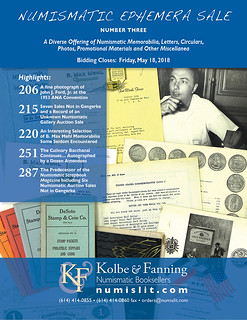 Kolbe & Fanning Numismatic Booksellers are announcing our third Numismatic Ephemera Sale, which will close on Friday, May 18, 2018. The sale
includes 100 lots of memorabilia, short sale catalogues, photographs, letters, brochures, leaflets, booklets: all sorts of material that doesn’t necessarily fit well in a book auction but which is interesting
nonetheless.
Kolbe & Fanning Numismatic Booksellers are announcing our third Numismatic Ephemera Sale, which will close on Friday, May 18, 2018. The sale
includes 100 lots of memorabilia, short sale catalogues, photographs, letters, brochures, leaflets, booklets: all sorts of material that doesn’t necessarily fit well in a book auction but which is interesting
nonetheless.
Items in the current sale include:
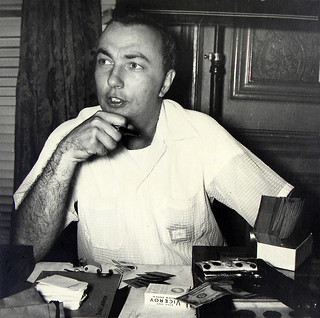
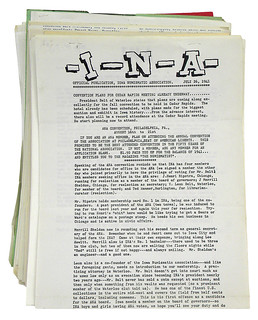
Lots 206 and 215
Lot 206: the famous photograph of John J. Ford, Jr. taken at the 1953 American Numismatic Association convention in Dallas, Texas.
Lot 215: seven sales not listed in Gengerke and a record of an unknown Numismatic Gallery auction sale.
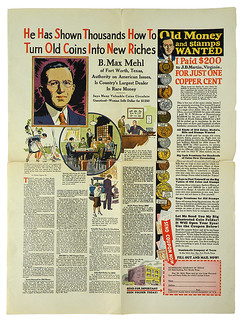
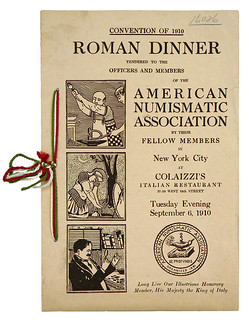
Lots 220 and 251
Lot 220: an interesting selection of B. Max Mehl memorabilia, some of it seldom encountered.
Lot 251: a menu for the 1910 ANA Convention dinner, signed by a dozen attendees.
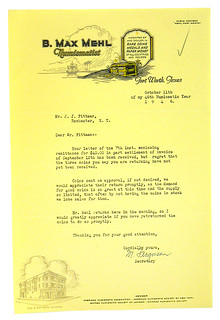

Lots 232 and 287
Lot 265: a British Government Act to allow Matthew Boulton to export coining equipment to Russia.
Lot 287: the predecessor of the Numismatic Scrapbook Magazine, including six numismatic auction sales not listed in Gengerke.
This is the first ephemera sale we have held since 2013. The catalogue is in PDF form only: there is no printed catalogue, nor is there online bidding. This is purely an old-school mail-bid sale. The catalogue may be downloaded from Kolbe & Fanning’s website at numislit.com. Please read the Terms of Sale. We thank you in advance for your participation!
To read the complete catalog, see:
Numismatic Ephemera Sale Number Three (https://www.numislit.com/images/upload/kolbefanningephem3.pdf)

ANS OFFERS SALE ON OLDER PUBLICATIONS
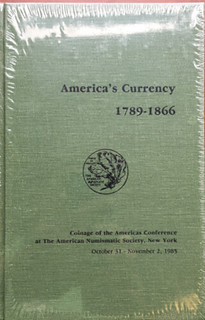 ’Tis the season for Spring Cleaning, and the ANS is making a number of older (and very early) titles available for purchase at a considerable discount. Complete your collections of the following series: American
Journal of Numismatics (Second Series), Ancient Coins in North American Collections (ACNAC), Coinage of the Americas Conference (COAC), ANS Annual Meeting Proceedings, ANS Annual Reports, ANS By-Laws, ANS
Magazine, Museum Notes (MN), Numismatic Literature (NL) and Numismatic Literature Quarterly (NLQ), Numismatic Notes and Monographs (NNM), Numismatic Studies (NS), and Sylloge Nummorum Graecorum (SNG).
’Tis the season for Spring Cleaning, and the ANS is making a number of older (and very early) titles available for purchase at a considerable discount. Complete your collections of the following series: American
Journal of Numismatics (Second Series), Ancient Coins in North American Collections (ACNAC), Coinage of the Americas Conference (COAC), ANS Annual Meeting Proceedings, ANS Annual Reports, ANS By-Laws, ANS
Magazine, Museum Notes (MN), Numismatic Literature (NL) and Numismatic Literature Quarterly (NLQ), Numismatic Notes and Monographs (NNM), Numismatic Studies (NS), and Sylloge Nummorum Graecorum (SNG).
These sale publications are available while quantities last in as-is condition (a few books are ex-library copies). Shipping will be calculated based on the size of your order. First come, first served. To order, email a list of the titles you want to Andrew Reinhard, Director of Publications. No phone calls please. No returns.
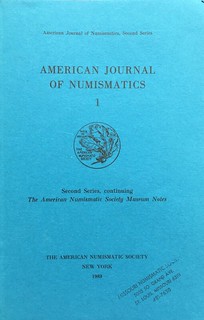

Note that the sale ends May 30, 2018. Here are a few selected titles available as of this afternoon. BUT CHECK THE WEB PAGE FOR AVAILABILITY BEFORE ORDERING. These are going fast, and some titles have already sold out. -Editor
Ancient Coins in North American Collections (ACNAC):
• The John Max Wulfing collection in Washington University (ACNAC 2)
U.S. Colonial Numismatics
• America’s Copper Coinage (COAC 1)
• America’s Currency, 1789–1866 (COAC 2)
• Coins of the American Confederation Period (COAC 11)
• Canada’s Money (COAC 8)
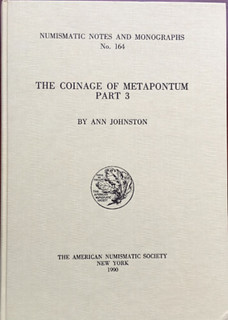
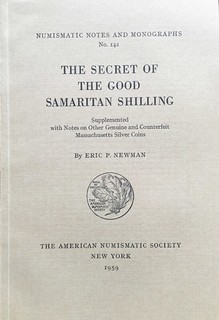
Numismatic Notes and Monographs (NNM):
• Coinage for Colonial Virginia (NNM 135)
• The Secret of the Good Samaritan shilling : supplemented with notes on other genuine and counterfeit Massachusetts silver coins (NNM 142)
Numismatic Studies (NS):
• The Early Cistophoric Coinage (NS 14)
• Alexander’s drachm mints I: Sardes and Miletus (NS 16)
• Studies in early Byzantine gold coinage (NS 17)
For the complete up-to-date list, see:
MAY “FIRE SALE” ON OLDER ANS PUBLICATIONS (http://numismatics.org/pocketchange/2018sale/)
SHANNA SCHMIDT DUPLICATE BOOK SALE
In her email Newsletter #67, ancient coin dealer Shanna Schmidt writes:
I’ve started offering duplicate copies of books that I own. I’m not trying to become a book dealer by any means but I would like to sell the books for what I put into them. Anyone that is building a numismatic library knows that it is inevitable that you will buy something you already have or get a full set of something which makes the single book you have not worth keeping. Check it out here: https://www.shannaschmidt.com/books/
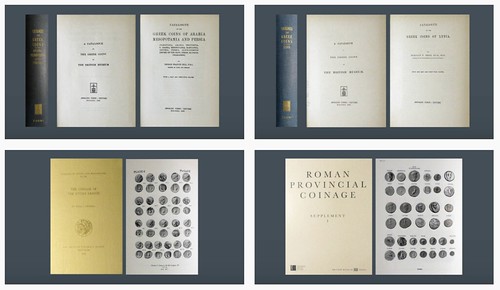
To read the complete article, see:
https://www.shannaschmidt.com/books/
NEW BOOK: 2019 HANDBOOK OF U.S. COINS
Expanded With Full-Color Sections
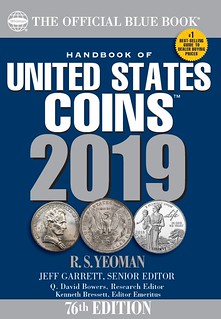 The newest edition of the Handbook of United States Coins debuts in late May 2018. Known to collectors as the Blue Book, it is
the best-selling annual guide to wholesale prices paid by U.S. coin dealers. The 304-page 76th edition, with a 2019 cover date, has been fully updated and expanded with a 16-page color section. It can be ordered online
(including at Whitman.com) in two formats—hardcover at $14.95 and softcover at $12.95—and will also be available from booksellers and hobby shops nationwide.
The newest edition of the Handbook of United States Coins debuts in late May 2018. Known to collectors as the Blue Book, it is
the best-selling annual guide to wholesale prices paid by U.S. coin dealers. The 304-page 76th edition, with a 2019 cover date, has been fully updated and expanded with a 16-page color section. It can be ordered online
(including at Whitman.com) in two formats—hardcover at $14.95 and softcover at $12.95—and will also be available from booksellers and hobby shops nationwide.
The Blue Book was introduced in 1942 as a resource for coin collectors to learn how much dealers were paying, on average, for U.S. coins. Whitman Publishing’s R.S. Yeoman, who was in charge of promoting the company’s line of coin boards and folders in the 1930s, realized that coin collectors needed other resources and supplies for their hobby, and he began gathering mintage data and market values. Yeoman’s coin-by-coin, grade-by-grade research grew into the Blue Book. It has been published every year since 1942 (except for 1944 and 1950), with millions of copies purchased by collectors and dealers.
Today’s Blue Book has more than 25,000 wholesale valuations in up to nine grades per coin type. It covers U.S. coins from copper half cents through gold double eagles, plus commemoratives; Proof and Mint sets; silver, gold, and platinum bullion coins; private and territorial gold pieces; private tokens; and 1903–1945 Philippine coins struck under U.S. sovereignty.
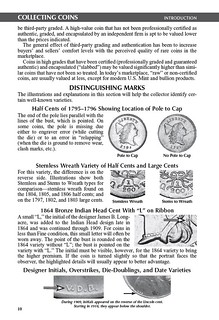

This year longtime editor Kenneth Bressett is retiring to the position of Editor Emeritus, with Valuations Editor Jeff Garrett taking the role of Senior Editor and Q. David Bowers continuing as the Blue Book’s Research Editor.
The new 16-page section in full color features an illustrated tribute to Bressett; a section on collecting U.S. Mint gold and silver medals, including American Arts gold medallions; and a photo-illustrated guide to grading Lincoln cents, Buffalo nickels, Mercury dimes, Barber and Liberty Seated silver coins, Standing Liberty quarters, Liberty Walking half dollars, and Morgan dollars. With enlarged grade-by-grade images of these popular coin types, this section is designed to educate new coin collectors, as well as non-collectors who have inherited or otherwise acquired old coins.
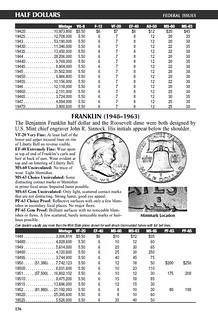
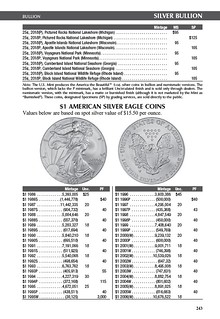
“We’ve heard from many coin dealers who wanted a feature like this,” said Whitman publisher Dennis Tucker. “Non-collectors who call coin shops often have no knowledge of grading, and they typically overestimate the condition of their coins. Grading is challenging to explain over the phone. The 2019 Blue Book guides the reader visually, with compare-and-contrast photos of Good, Very Fine, and Mint State examples for more than a half dozen of the most commonly seen old coins.”
The “Quarter Dollars,” “Commemoratives,” “Proof and Mint Sets,” and “Platinum and Palladium Bullion” sections have all been expanded.
In addition to these new and expanded features, the 76th-edition Blue Book includes a helpful glossary of coin-collecting jargon, and a bibliography of books recommended for further hobby education.

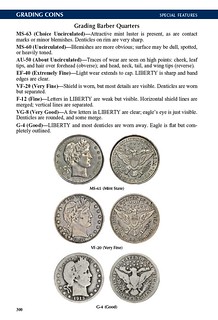
The cover of the softbound 76th edition shows three beautiful and historic American coins: a 1918 Illinois Centennial commemorative half dollar (with a clean-shaven portrait of Abraham Lincoln based on the statue by Andrew O’Connor in Springfield, Illinois); the reverse of the classic Morgan silver dollar; and the new 2018 “Preamble to the Constitution” American Platinum Eagle, with the design of “Life.”
Beth Deisher, author of Cash In Your Coins: Selling the Rare Coins You’ve Inherited, has said, “The Blue Book is the only price guide available to the public that brings reality to selling rare and collectible coins. Based on prices dealers are likely to offer, it provides you the necessary tools to accurately identify your coins and value your collection.”
About the Handbook of United States Coins
The Handbook of United States Coins is the world’s most popular annual wholesale (“buy price”) guide for U.S. coins, tokens, and other numismatic items. Millions of copies have been purchased since 1942, making it one
of the best-selling titles in the history of numismatic publishing, second only to the annual Guide Book of United States Coins (the retail-pricing “Red Book”).
For the 76th edition, more than 140 professional coin dealers, scholars, and other numismatic experts contributed their knowledge under the direction of Senior Editor Jeff Garrett, Research Editor Q. David Bowers, and Editor Emeritus Kenneth Bressett.
The 76th edition of the Blue Book is available online and at bookstores and hobby shops nationwide.
For more information or to order, see:
https://www.whitman.com/store/Inventory/Browse/2019-Red-Books-and-Blue-Books
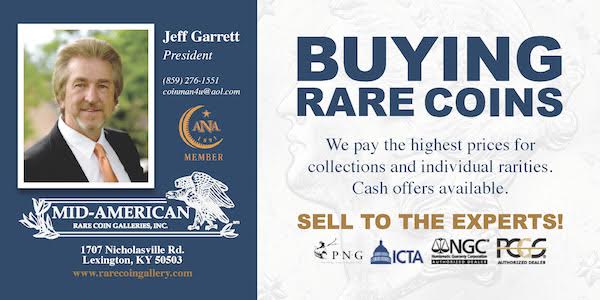
BOOK REVIEW: THE EARLY COINS OF MYANMAR
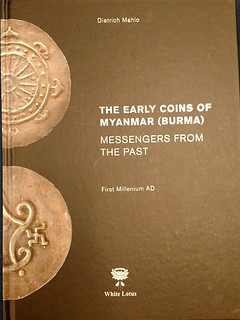 I was surprised to see The Early Coins of Myanmar (Burma),
Messengers from the Past book appear in The Esylum, that Bob Leonard showed to you. I bought my copy at the Kinokuniya Bookstore in the Siam Paragon Shopping Mall in Bangkok shortly after it was published in 2012. It is one
of the best bookstores in East Asia!
I was surprised to see The Early Coins of Myanmar (Burma),
Messengers from the Past book appear in The Esylum, that Bob Leonard showed to you. I bought my copy at the Kinokuniya Bookstore in the Siam Paragon Shopping Mall in Bangkok shortly after it was published in 2012. It is one
of the best bookstores in East Asia!
This numismatic book is not well known but it should be because it is a fantastic piece of work. It convinced me that if I ever produce a catalog for Myanmar (Burma) in my format, I should start sometime in the mid-19th century and not go back to day one. There are thousands of coins that are in Myanmar's National Museum and only a small percentage have ever been researched and published. I am not sure I have time to start that research.
The book was published by White Lotus Books in Bangkok. My friend, Ande, is the owner and he can be reached at ande@loxinfo.co.th . The author's daughter, Sophie Mahlo, lives in Berlin and can be reached at heresthethingwelike@gmail.com I believe you can still buy the book from either of them. She has been working to sell her father's book so that more numismatists know about it. It is not a low priced book but it is worth every bit of the price if you are interested in Southeast Asian numismatics because these coins circulated far and wide in the region.
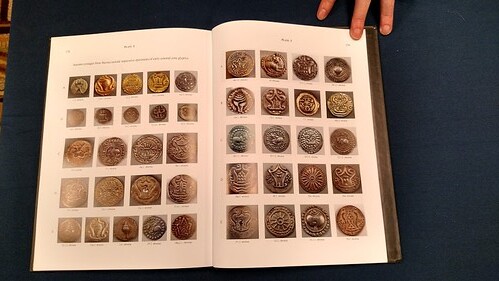
To read the earlier E-Sylum article, see:
WAYNE'S NUMISMATIC DIARY: APRIL 29, 2018 : The Chicago Coin Expo (http://www.coinbooks.org/v21/esylum_v21n17a31.html)
BOOK REVIEW: MATTHEW BOULTON’S NAVAL MEDALS
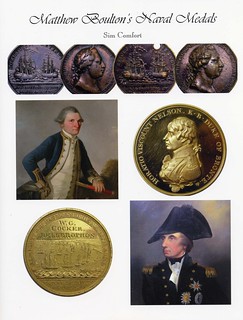 During the course of my current research I purchased Sim Comfort’s new book, Matthew Boulton’s Naval Medals. I found it to be the best numismatic book I have read in many years. As such, I am compelled to
draw attention to it so that others might purchase it and enjoy what it has to offer. The author is a U.S. Navy veteran who has lived in London since the 1960s – leave it to a Yank to write the definitive book on Boulton’s
naval medals! Sim’s love for the sea no doubt drew him to the subject matter.
During the course of my current research I purchased Sim Comfort’s new book, Matthew Boulton’s Naval Medals. I found it to be the best numismatic book I have read in many years. As such, I am compelled to
draw attention to it so that others might purchase it and enjoy what it has to offer. The author is a U.S. Navy veteran who has lived in London since the 1960s – leave it to a Yank to write the definitive book on Boulton’s
naval medals! Sim’s love for the sea no doubt drew him to the subject matter.
Before I describe the book’s contents, I would like to discuss its physical characteristics, which are eye-popping. As someone who has authored his own book and collected numismatic works for years, I have grown to appreciate this aspect of a book more and more. This book is of the highest quality. The only thing more I could possibly think to ask for would be leather binding.
The book comprises 412 pages printed on Munken Arctic Matt White 90 gsm paper, with color images throughout. It is sewn bound as a quarto volume (11.25 inches x 8.65 inches) complete with a beautifully illustrated dust jacket. The print run was limited to 500 copies. I purchased my copy from Charles Davis’s numismatic book website and my copy came signed by the author and hand-numbered – I received No. 50. I found this to be an unexpected and very nice touch. The book appears to be self-published. This makes sense as I doubt a modern publishing house would agree to produce such a handsome volume today. All the right choices were made by the author in his selections for what is clearly a labor of love. The book also includes a great index, which for my purposes as a researcher is greatly appreciated. What struck me most about the book’s appearance, however, were the many rich color photographs. Every medal is depicted, plus many lovely historical images of people, places, and battles.
I needed this book for a very limited research purpose. When it arrived, I turned to the index, found what I wanted, and went directly to that page. What I was looking for was there and I read it, then I read the next paragraph, and the next page until I stopped myself and decided to start from the beginning. Despite having a stack of books to read in my study, I began to read this book on Matthew Boulton naval medals that has little to do with my overall research or general interest (I do not collect naval medals) – the story, however, pulled me in and Sim’s prose and illustrations kept me reading. I like to think of myself as a rather sophisticated numismatist, but every chapter brought new revelations to me.
Matthew Boulton produced seven naval medals over the course of his life – the Otaheite (Resolution and Adventure), Admiral Rodney’s St. Eustatia, Earl Howe’s Glorious First of June, Davison’s Nile, Ferdinand IV, Earl St. Vincent’s, and his Trafalgar Medals. Each medal is discussed in detail. What makes a good numismatic book in my view are six things. 1) great illustrations; 2) a technical discussion of the numismatic items; 3) original research; 4) great writing; 5) an interesting story; and 6) placing the numismatic items into their proper historical context. Sim’s book does all of these things.
Matthew Boulton was a prodigious note taker and letter writer and his papers have largely been preserved. He was an entrepreneur to be sure, but he also had a great passion for engineering and mechanical processes. Sim has pulled from Boulton’s writings the technical information regarding how he minted his naval medals. This is a great boon for researchers of the era. It is technical information like this, in my opinion, that makes a book a numismatic book rather than just a history or coin book. Let’s face it, however, reading 400 plus pages of technical information on coins would be too much and if that is all the book had to offer I would have just read the few paragraphs I needed for my research and put it away in my library. The art of combining the technical with the historical story of the medals is what kept me reading. Fortunately, Boulton’s rich paper trail permits us to follow the story of both the medals and general history closely and accurately.
While others may enjoy a different aspect of the book, I particularly found the story of the Otaheite (Resolution and Adventure) medal fascinating. This medal was Boulton’s first effort and it accompanied Capt. James Cook on his second exploratory voyage in 1772. The idea was to give the medals to indigenous people encountered on the voyage.
Boulton manufactured this medal prior to his application of steam power to the medal and coin-making process. We view Boulton today as a man who produced superior medals in abundance, but forget his early ventures where he simply took what he knew from button manufacturing and applied it to medal-making. This was a period of trial and error for Boulton and by reading this story I was able to learn a great deal about early coin and medal manufacturing that I believe is directly applicable to American Colonial numismatics. I also learned a great deal about Matthew Boulton and came away impressed by his ability to overcame adversity and learn from his mistakes and grow as a coin and medal-maker.
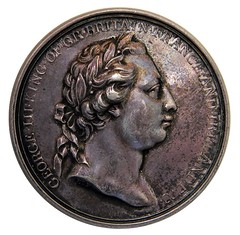
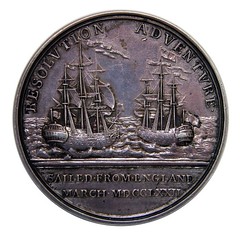
Each of Boulton’s naval medals has a similar technical and historical account behind it and Sim’s captures all these stories in a compelling way. The reader also gets a direct connection with the past as Sim’s world-class collection of medals includes what must be the greatest assemblage of medals engraved with the recipients’ names ever gathered. I did not even know such things existed! Here are images of medals with the inscribed names of the men who fought at Trafalgar and other great battles along with their personal stories.
Many of the sailors cherished their medals so much they wore them around their neck or carried them in specially designed cases; produced, of course, by Mr. Boulton, who seldom let a business opportunity pass. With that said, the Trafalgar medals were all made at Boulton’s personal expense after he realized that the common sailor was to receive no award or memento of the great battle. I will be keeping a sharp eye out for these medals in the future. Fortunately, Sim gives hints as to how to spot spurious naval medals – something greatly appreciated by this novice medal collector.
I would be remiss if I did not add one final thing about Sim Comfort. After reading the book, and already deciding to write this review, I realized I needed an image of the rim of one of the naval medals for my research. This particular medal’s rim was not illustrated in the book, although many others are. I located Sim’s email in London and sent him a message telling him how much I liked his book and asked him if he would please photograph the rim of this very rare medal for me and send it to me for my research.
I realize this was an unusual request from a total stranger, but I had no other means of acquiring what I needed. Within 24 hours Sim responded to me, answered my questions, took the photograph I requested, and sent it to me for my use. Therefore, I can attest that in addition to writing one of the best numismatic books I have ever read, I can say that Sim Comfort is an outstanding and approachable gentleman willing to help a fellow numismatist in need. I really cannot say enough about the book or Sim. I give this book my highest recommendation – 5 stars!
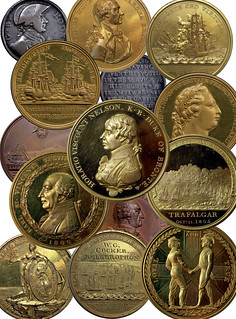 The catalogue provides a comprehensive collection of seven St Vincent, 34
Davison Nile and 33 Boulton Trafalgar medals that are named or provenanced. Within the catalogue, the stories of these named men, and a few women who are believed to have been on board as well, are told along with what their
ships went through at both the Nile and Trafalgar. Included for the Nile are the accounts by the American Captain Ralph Miller who commanded the Theseus and the French artist and author Vivant Denon, who witnessed the
battle. Personal sea stories are based on research at the National Archives and other contemporary material. A comprehensive index of ships and men is also included.
The catalogue provides a comprehensive collection of seven St Vincent, 34
Davison Nile and 33 Boulton Trafalgar medals that are named or provenanced. Within the catalogue, the stories of these named men, and a few women who are believed to have been on board as well, are told along with what their
ships went through at both the Nile and Trafalgar. Included for the Nile are the accounts by the American Captain Ralph Miller who commanded the Theseus and the French artist and author Vivant Denon, who witnessed the
battle. Personal sea stories are based on research at the National Archives and other contemporary material. A comprehensive index of ships and men is also included.
Written by a collector for other collectors and museum curators, this work will no doubt prove a valuable reference for all interested parties. It is with the support of Britain’s major museums that this publication has been made possible.
ISBN 978-0-905887-11-1
The book comprises 432 pages printed on Munken Arctic Matt White 90 gsm paper, with colour throughout. It is sewn bound as a quarto volume (28.5 cm / 11.25 inches x 22 cm / 8.65 inches) complete with dust wrapper. The limited edition of 500 copies is available for £125.00 plus postage.
To order, please email for payment details and shipping costs to sim@simcomfort.co.uk or telephone us in England on 44 (0) 20 8944 8747.
For more information, or to order, see:
UK: Matthew Boulton's Naval Medals (http://www.simcomfort.co.uk/matthew_boulton.htm)
US: Comfort: Matthew Boulton's Naval Medals
(https://www.vcoins.com/en/stores/charles_davis/44/product/
comfort_matthew_boultons_naval_medals/852075/Default.aspx)
BOOK REVIEW: THE MANILLA MONEY OF WEST AFRICA
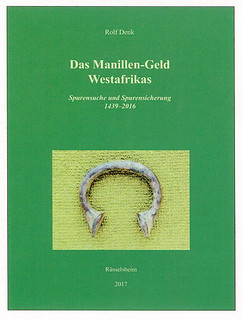 The Manilla Money of West Africa
The Manilla Money of West Africa
Searching for Traces and Forensics 1439 - 2016
The money manillas from Portugal, England and France are among the best-known non-monetary means of payment in West Africa.
Arm, foot and neck are probably the most widespread jewelery objects in Africa. The interested person is thus faced with the task of determining from the flood of metallic hoops and rings those that were really made and used as non-monetary means of payment
Denk supports the collector (ethnologists, traders, museum administrators, historians, etc.) in this differentiation with scientific completeness and accuracy. He "animates" his objects by placing them in their historical and ethnological context and showing their significance for the colonial policy of the time - money manillas have always been a product manufactured and imported by the Europeans.
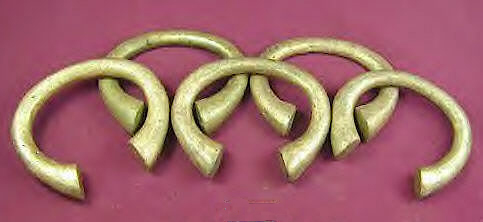
It has become the reference work in this field.
Think, Rolf: The manilla money of West Africa. Searching for evidence and forensics 1439-2016. Rüsselsheim 2017, 247 pages. Hardcover 55,00 EUR, Paperback 35,00 EUR. (book on demand)
To read the complete article, see:
BOOK REVIEW: The Manilla Money of West Africa
(http://www.eucoprimo.com/2017/11/13/buchbesprechung-das-manillen-geld-westafrikas/)
BOOK REVIEW: WOMEN, PIGS AND SHELLS
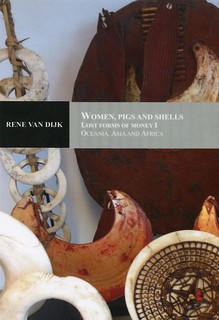 Van Dijk, René : Women, Pigs and Shells - Lost Forms of Money I
Dowry Payment, Burial Money, Hoarding, Means of Exchange and Status - Symbol.Rijswijk oO 2016, 475 pages. ISBN: 978-90-825239-2-8
Van Dijk, René : Women, Pigs and Shells - Lost Forms of Money I
Dowry Payment, Burial Money, Hoarding, Means of Exchange and Status - Symbol.Rijswijk oO 2016, 475 pages. ISBN: 978-90-825239-2-8
This book is a translation of the first of two Dutch-language publications (2016) into English.
This volume deals with Oceania (pp. 22-191), Asia (pp. 194-281) and Africa (pp. 284-462), with the chapters on Oceania and Africa divided into "Lost Forms of Money" (both Chapter) and "Ornament (-money)" cap. Oceania or "Prestige objects and adornment money" - Chap. Africa.
Outline principle is the arrangement of the individual objects in the alphabet - probably following the example of Opitz - with the dilemma of having to accept a mixture of native names and English: Not every reader is z. For example, the Trobriand skirts can be found under the name "skirt-money" (p. 114f.) Or the so-called Chinese soul locks (p. 251) under the name "Silver adornment money" or the chains of Buschmann pearls under the name "Egg shell chain "(page 345). For the most part, information on measures and weights of the objects, eg. T. also to the materials used. One would also like to know which of the presented objects belong to the collection of the author and which may not.
The author has explained in the introductions his intentions with the publication. He had the desire "to document my entire collection with the specification of background" (p. 13) - "The purpose of the book is to describe the most prominent lost forms of money of the world and to provide some background to them." P. 14) - and he wanted to close a literature gap for the Netherlands, "providing some background information". , (P. 15) The latter succeeded him; There is no comparable publication on the subject that provides so much text, image and map material on the treated objects.
Of course, there are some gaps in the intended completeness of the relevant forms of money; For example, the author has disregarded many forms of commodity money, African-imported forms of money such as coral beads, Neptunes, Indian and European textiles, firearms and gunpowder.
The author has given as its main sources of knowledge the "outstanding reference works" of Quiggin and Opitz, as well as the Ballarini for Africa and the Taxay for America. Opitz and Ballarini are but only z. T. acceptable as references, since they present rows of objects that are not protected by source. In contrast, you miss reference works such. B. Only, Rivallain and German. The fact that the author made use of many (but not all) relevant contributions from the "primitive money collector" was certainly useful, as these contributions are well documented in terms of source.
To read the complete article, see:
Fritz Klusmeier: Van Dijk, René : Women, Pigs and Shells - Lost Forms of Money I (http://www.eucoprimo.com/2017/02/17/buchbesprechung/)
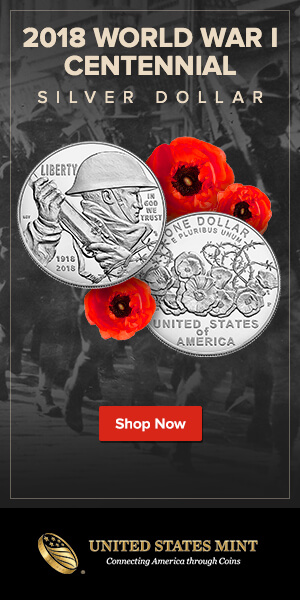
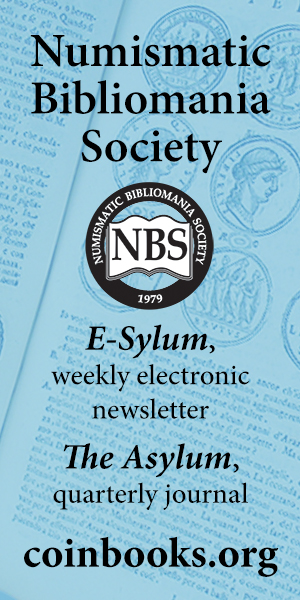
NLG ANNOUNCES NEW AWARD CATEGORIES FOR 2018

The Numismatic Literary Guild (www.NLGonline.org), a nonprofit organization composed of editors, authors and writers who cover news and feature stories about all forms of money, medals and tokens as collectibles, has substantially revised its annual awards competition categories for 2018 and beyond.
“Working with awards coordinator Scott A. Travers and NLG board members John Albanese, David T. Alexander, Michael R. Fuljenz, Charles Morgan, Maurice Rosen, and other veteran hobby editors and writers, we reorganized the categories and brought the Guild into the 21 st century," said NLG Acting Executive Director Donn Pearlman. "We were overdue in recognizing that important numismatic-related information is available online and in media other than print."
To be eligible for consideration in any of this year’s categories, entries must have been published, released, or posted on the Internet between May 1, 2017 and April 30, 2018. With the exception of the Portfolio category, three (3) copies of each entry must be submitted, and each copy must also be accompanied by a cover sheet listing the category and other information spelled out in the rules.
Only one entry per category is allowed per submitter.
All entries must be received no later than Tuesday, June 12, 2018. They should be sent to the contest coordinator at the following address: Scott A. Travers, c/o Sal Germano, SGRC Inc., 625 Lafayette Ave., Hawthorne, NJ 07506.
“Entries in a number of categories will be judged by editors and other well- qualified individuals within and outside the numismatic field," Travers commented.
Winners will be announced, and awards presented, at the 2018 NLG Bash and Awards Ceremony on Thursday, August 16, 2018, at the American Numismatic Association World's Fair of Money® in Philadelphia, Pennsylvania.
To read the complete rules and list of categories, see:
Numismatic Literary Guild Announces New Award Categories for 2018
(https://www.nlgonline.org/news/numismatic-literary-guild-announces-new-award-categories-for-2018/)
NORTHWEST TERRITORIAL MINT OFFICERS ARRESTED
The former president and a manager of a South King County precious-metals company on Monday pleaded not guilty to 20 felony counts of wire fraud and mail fraud for allegedly running a Ponzi-like scheme that cost customers and investors more than $35 million.
The indictment alleges that Bernard Ross Hansen, the founder and CEO of Northwest Territorial Mint, and his girlfriend and vault manager, Diane Renee Erdmann, bilked more than 3,000 customers out of nearly $25 million, and ran two other scams that cost a number of other customers another $10 million.
The indictment was handed up by a grand jury last week and unsealed after Hansen and Erdmann were arrested on Monday.
According to the indictment, by 2012 the mint — which made coins and medallions and bought, sold and stored precious metals — lacked assets to fill customer orders, and federal prosecutors allege they started using the investments from new customers to pay money owed to older customers in an illegal Ponzi-like scheme.
To read the complete article, see:
Operators of South Sound precious-metals firm indicted in alleged $25M Ponzi scheme
(https://www.seattletimes.com/business/operators-of-south-sound-precious-metals-firm-indicted-in-alleged-25m-ponzi-scheme/)
To read the earlier E-Sylum article, see:
NORTHWEST TERRITORIAL MINT ASSET SALES (http://www.coinbooks.org/v21/esylum_v21n10a15.html)
ANS BIDDING ON MEDALLIC ART COMPANY ASSETS

By early February, I was ready to turn to some long overdue correspondence and administration, when my colleagues and I received an email that greatly alarmed us. We heard something new concerning the North West Territorial Mint (NWTM) chapter 11 bankruptcy proceeding. After an unsuccessful attempt to reorganize the business, the Trustee in charge announced that he would liquidate all assets. Why this matters so much to the Society is that NWTM also owns the Medallic Art Company (MACO), the longest-lasting and arguably most important private mint in the US. Like many other institutions, the ANS has long been using MACO to strike its medals, including the Huntington Award and Saltus Award medals.
Since its foundation in New York City in 1903, MACO has served generations of America's finest sculptors and other artists in the production of their work, as well as countless non-profit and for-profit institutions in their desires to produce various commemorative, award, and other medals. Because medals have long been recognized as a standalone art medium, and one that is that is far more affordable to acquire than larger sculptures or paintings, MACO has also served to put fine art into the hands of many Americans who might not otherwise have had the chance to own the original work of a great artist.
What was now proposed, and without much warning to the institutions or artists concerned, was a sale of the dies, galvanos, sample medals as well as, of course, all machinery and other assets. When I approached the Trustee in charge of the proceedings, we learned that the dies were considered to be simply tools and thus the property of MACO, not of the institutions or artists. It was then proposed that the ANS bid for the holdings of dies, galvanos and samples (although only those prior to 1997). At this point, ANS Trustee Mary Lannin and I decided to visit the company's facilities in Nevada in order to get a better idea of their holdings. What we saw there was an extraordinary archive of medallic art, covering the entire twentieth century, in which works of many of the most famous sculptors were represented. Further, the archives provide an extraordinary overview of a slice of American history from the perspective of companies, clubs, schools and so on, many of which are extinct today.
As often in bankruptcy auctions; the assets of a company might be dispersed, or, as a real threat in this case, leave the United States altogether. Losing the dies and archives as well as the extraordinary cataloguing work that has been put into preserving everything for the last 115 years would be a huge loss to future generations. Should these dies fall into the wrong hands, particularly those beyond the reach of US law enforcement, unauthorized medals could be produced confounding awardees, collectors, and the institutions themselves.
The Trustees of the American Numismatic Society therefore decided to place a bid for this material. At the time of writing, we are all waiting to see what the judge in this case decides. If successful, the ANS will be able continue its role as one of the stewards of medallic art in this country. We will keep our membership informed as this story develops!
We are still waiting to be able to place our bid for the older material in order to preserve the history of the Medallic Art Company. On Friday, the judge granted the sale for the more recent, post-1998 dies and galvanos and some other assets to Medalcraft, Inc.
To read the earlier E-Sylum article, see:
NORTHWEST TERRITORIAL MINT ASSET SALES (http://www.coinbooks.org/v21/esylum_v21n10a15.html)
For an ongoing blog on developments, see:
http://about.ag/NWTMint.htm

LOVE TOKEN SOCIETY JOURNALS ON NEWMAN PORTAL
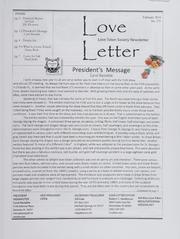 The Newman Portal has recently digitized The Love Letter, published by the Love Token Society. Issues from 1972 to 2011 can be found under
“periodicals” in the library section of the Newman Portal. “Love tokens” are artistically altered coins and were especially popular in the 19th century.
The Newman Portal has recently digitized The Love Letter, published by the Love Token Society. Issues from 1972 to 2011 can be found under
“periodicals” in the library section of the Newman Portal. “Love tokens” are artistically altered coins and were especially popular in the 19th century.
Within U.S. coinage, love tokens were often made using Liberty Seated dimes as host coins, though all denominations were used to a varying extent. In the August 2011 issue of The Love Letter, Russ Frank explores love tokens fashioned from Columbian Exposition half dollars.
Many love tokens exhibit exquisite detail, and these examples of folk art have been the focus of the Love Token Society for nearly 50 years. The Newman Portal acknowledges Carol Bastable, president of the Love Token Society, for assistance with this project.
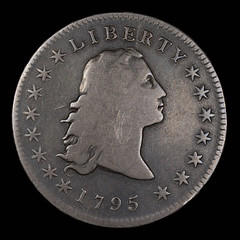
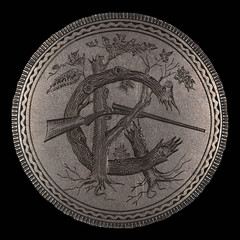
Image: Love token on 1795 bust dollar, from the Eclectic Numismatic Treasure collection
Link to The Love Letter on Newman Portal:
https://nnp.wustl.edu/library/publisherdetail/526066
Love tokens from the Eclectic Numismatic Treasure collection on Newman Portal:
https://nnp.wustl.edu/library/imagecollection/510918
Love Token Society home page:
http://lovetokensociety.com/
NEWMAN PORTAL SEARCH: PLATE MONEY
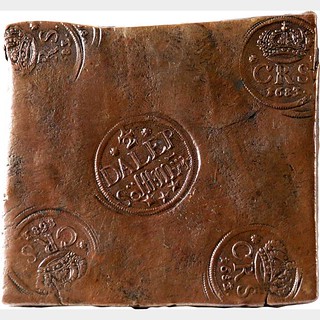 A Newman Portal user searched this week for “plate money.” One of the search results points to the January 2015 Stack’s Bowers New York International auction sale catalog, which featured the Stanley Aberdeen
collection of Swedish plate money. Most collectors are only vaguely familiar with plate money as a form of “odd and curious” money, so Stack’s has helpfully included a brief overview of the series.
A Newman Portal user searched this week for “plate money.” One of the search results points to the January 2015 Stack’s Bowers New York International auction sale catalog, which featured the Stanley Aberdeen
collection of Swedish plate money. Most collectors are only vaguely familiar with plate money as a form of “odd and curious” money, so Stack’s has helpfully included a brief overview of the series.
These curious plates of copper were issued by Sweden from 1644 to 1776 in denominations from the 1/2 to 10 Daler. Records indicate 48 million were manufactured, of which 11,000 were believed to exist as of 1986. Typical examples are valued between $1,000 and $2,000, though exceptional pieces will command more. Increased circulation of paper money was a factor in their demise, not a surprise as the first examples of plate money weighed over 40 pounds!
Image: Swedish ½ Daler Plate Money, 1683, from Stack’s Bowers January 2015 sale, lot 1643 (realized $7.637.50). Actual size 4.75 x 4.25 in.
Link to Stack’s Bowers January 2015 catalog on Newman Portal:
https://nnp.wustl.edu/library/auctionlots?AucCoId=3&AuctionId=517154&page=304
THE FIRST COINS OF THE DENVER MINT
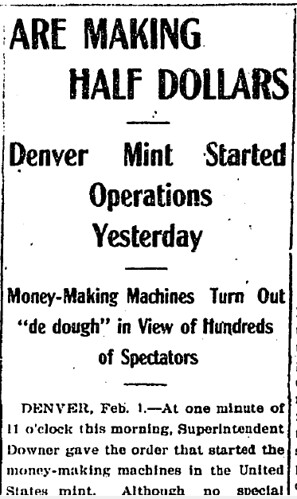 What was the first coin struck by the Denver Mint? Until now, we did not know.
According to the research of ANS Fellow Kurt Baty of Austin, Texas, that initial issue was the half dollar of 1906. Although numismatists have long been confident of the histories of the main Mint in Philadelphia and six of
the branch Mints, this detail from the Denver facility remained hidden. It came to light through an insightful Internet search of key words. In fact, it may have only been through the power of the Internet that this detail
was discovered because it was never recorded by the Mint itself in any official reports.
What was the first coin struck by the Denver Mint? Until now, we did not know.
According to the research of ANS Fellow Kurt Baty of Austin, Texas, that initial issue was the half dollar of 1906. Although numismatists have long been confident of the histories of the main Mint in Philadelphia and six of
the branch Mints, this detail from the Denver facility remained hidden. It came to light through an insightful Internet search of key words. In fact, it may have only been through the power of the Internet that this detail
was discovered because it was never recorded by the Mint itself in any official reports.
“It started with a rather simple question,” Kurt Baty explained. “If I wanted to have a U.S. Mint mintmark set, what could it look like?” In other words, we have had eight U.S. Mints: Philadelphia, Charlotte, Dahlonega, New Orleans, San Francisco, Carson City, Denver, and West Point. How you choose to assemble a set of one coin from each Mint is up to you.
We seem to know some official account which is generally correct for each of the other Mints. For instance, we accept now that the first coins struck under the authority of the main facility in Philadelphia were half dimes (spelled “dismes” back then). Similarly, it is well recorded that the first coins struck at the New Orleans branch were dimes: 1838-O Liberty Seated, Type 1, No Stars.
The series that launched the Carson City Mint were “a few” 1870 Liberty Seated silver dollars struck on (or prior to) February 4, 1870. They were followed by a run of 2,303 on February 11. That fact was also not well known until the publication of the Stacks Bowers auction catalog for the ANA convention in Philadelphia August 7-11, 2012. The sales were held on the first two nights. For the catalog, lot number 11077 was an 1870-CC Liberty Seated Silver Dollar, Variety 1-D, MS-64 (PCGS) in a secure holder. (It sold for $129,250.) For the lot description, the researchers at Stacks Bowers provided a full narrative citing newspaper reports from the Virginia City Territorial Enterprise for February 5, 1870 and the Carson Daily Appeal of February 6, 1870. That history was slightly modified in A Guide Book of The United States Mint: Colonial, State, Private, Territorial, and Federal Coining Facilities by Q. David Bowers (Whitman Publishing LLC, 2016). There, Bowers dates the first Carson City silver dollars from February 10.

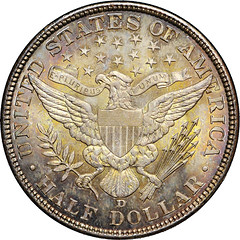
1906-D Half Dollar. Image: NGC Coin Explorer
Finding the newspaper stories cited in the Stacks Bowers catalog, Kurt Baty pointed his browser’s search engines to similar media for reporting about the Denver Mint. He struck pay dirt. At the website www.ColoradoHistoricNewspapers.org he found a story from the Aspen Democrat for February 2, 1906.
The frontpage top-of-the-fold account was headlined “ARE MAKING HALF DOLLARS.” According to that article, datelined Denver, February 1:
“At one minute of 11 o’clock this morning, Superintendent Downer gave the order that started the money-making machines in the United States mint. Although no special ceremony marked the opening of the mint, the balconies above the stamping rolling, and adjusting rooms were packed with visitors who watched the fascinating work below. The day was given up to the making of half dollars. The silver had been received from the subtreasuries in St. Louis and Chicago, in the form of uncurrent and abraded coin, which had been found wanting, so they were melted into small bars for coinage. A noticeable feature of the machines is that each one has a separate motor; so that everything in the United States mint runs independently of everything else.”
To read the complete issue, see:
https://www.coloradohistoricnewspapers.org/cgi-bin/colorado?a=d&d=TAD19060202.2.7
For more information on the 1906-D Half Dollar, see:
BARBER HALF DOLLARS 1906 D 50C MS
(https://www.ngccoin.com/coin-explorer/barber-half-dollars-pscid-41/1906-d-50c-ms-coinid-16505)

THE BULL'S RUN SATIRICAL MEDAL
Author Peter Bertram writes:
The Bull's Run satirical medal was totally unknown to me until Alan Weinberg sent me images of his specimen. With so much suspicious material out there I was rather skeptical at first. After a little digging around however, I found it was originally announced in the October, 1879 American Journal of Numismatics - also Joe Levine had handled two of them, so I was convinced.
The attached is my write up of it for my Confederate Numismatica 2018 Supplement One (target August) in progress. I thought perhaps the readers might enjoy a "sneak peek".
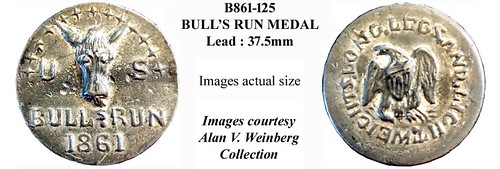
These crudely cast Confederate satirical medals are very rare indeed with only three specimens currently known (that I’m aware of). A fourth one announcing the medal’s existence was noted as “A MEMENTO OF BULL’S RUN” in the October, 1879 issue of the American Journal of Numismatics. It was a lead medal in Cleveland’s Historical Society and was described as
“…the size of an old dollar. The device of the obverse is a full-face ass’s head, over and around which is a three-quarter circle of thirteen stars; on either side the letters ‘U.S.’ and below, across the field, ‘Bull’s Run, 1861.’ An eagle occupies the center of the reverse; and the legend ‘Long Legs and Live Weights,’ encircles the field”
“Live” should actually be “Light” per the images shown here.
At the Battle of First Bull (not Bull’s) Run, Union General Irvin McDowell’s new army attacked Confederate Generals PGT Beauregard and Joseph E. Johnston on July 21 near Centreville, Virginia. Successful at first, the attack failed as Confederate reinforce-ments from the Shenandoah Valley arrived, broke the Union right flank and pressed hard, turning the Federal retreat into a complete rout. The medal’s satirical legend was thus read as “US bulls run,” with “Long Legs” referring to how fast the Union soldiers ran, and “Light Weights” describing their frantic discarding of arms, accouterments, etc - anything and everything which might have slowed them down.
Alan Weinberg won the eBay auction for his finest known copy above, and Joseph Levine (Presidential Coin & Antique Co) sold the other two – one of them to Richard Gross who reports he still has his copy and it’s for sale (ms67.rick.g@gmail.com).

To read earlier E-Sylum articles on Peter's book, see:
NEW BOOK: CONFEDERATE NUMISMATICA, PART 1 (http://www.coinbooks.org/esylum_v19n30a04.html)
BOOK REVIEW: CONFEDERATE NUMISMATICA (http://www.coinbooks.org/esylum_v19n31a11.html)
NOTES FROM E-SYLUM READERS: MAY 6, 2018
Wolfson's 1854-S Half Eagle
Alan V. Weinberg writes:
I may be the only person still alive, aside from Harvey Stack, who distinctly recalls Sam Wolfson's 1854-S half eagle auctioning in 1962-63 to Abe Kosoff. Abe sat near the front left side of room, on the aisle, I was near the rear right side of the room. It wasn't a big room and maybe 60% full.
There was no commotion in the room when Abe bought it...just like it was another half eagle. Wolfson's 1804 dollar sold for $28K to "Fairbanks".
A year earlier I had to turn down the Brand Brasher Doubloon for $14K.
To read the earlier E-Sylum article, see:
1854-S HALF EAGLE DISCOVERY (http://www.coinbooks.org/v21/esylum_v21n16a13.html)
Query: Letters on a Thailand Specimen Note
Howard A. Daniel III writes:
Jan Aamlid is an advanced collector and researcher in Thai numismatics. He is writing a book about Thai paper money and is trying to discover what some letters on a Thomas De LaRue printed specimen mean. What does the SO and G mean on this note? Do any of our readers know the answer? Jan can be reached at coin@loxinfo.co.th and I am at hadaniel3@msn.com .

On Adjustment Marks
Mark Borckardt writes:
A clue to adjustment marks is the weak strike on the other side opposing those marks. Not true for scratches.
Bill Eckberg writes:
I was always taught that you can’t define a term using another form of the same term, such as defining a runner as someone who runs. How about:
“Evidence of removal of metal from a planchet prior to striking. This was done to overweight planchets to bring the precious metal content down to legal specifications. These may appear...”
To read the earlier E-Sylum article, see:
VOCABULARY TERM: ADJUSTMENT MARKS (http://www.coinbooks.org/v21/esylum_v21n17a19.html)
On Disposing of Hobby Award Medals
John Regitko of Canada writes:
Regarding the last E-Sylum article "Mother and Daughter at odds over hero's medals," It reminds me of the conversations I have had with my numismatic friends who have been awarded presentation medals of how to dispose of them while they are still alive.
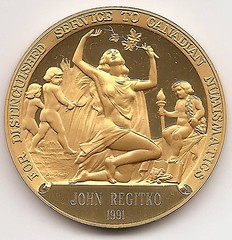 The medals we receive for doing good deeds in the hobby might not equal those of the hero's medals, but the problem and decision as to what to do with
them is the same. Without fail, the collectors I have spoken to are all in agreement that awards medals with their name on them should not be sold or placed in an auction while they are alive.
The medals we receive for doing good deeds in the hobby might not equal those of the hero's medals, but the problem and decision as to what to do with
them is the same. Without fail, the collectors I have spoken to are all in agreement that awards medals with their name on them should not be sold or placed in an auction while they are alive.
However, my family has no idea what to do with them when I pass on. Although I might explain which ones are gold and which ones are only gold plated, or ask my wife to contact a collector that I have befriended over the years, I don't feel comfortable that she will receive their true value or wind up in the hands of someone that will appreciate them other than for any financial benefit they might obtain from their resale.
The 24 or so personalized medals at this stage in my life do not mean as much to me as the great memories I have of my involvement that "earned" them. As well, my wife has no attachment to my medals, nor the 13 she herself received for her involvement in the RCNA, ONA (Ontario, not Ohio) and local coin club shows, who also has fond memories of her involvement.
Donating them to the RCNA archives would mean they will just sit in someone else's basement rather than mine.
Do your readers have any thoughts of how people can benefit from their reward without being criticized for their decision?
One thought I have is to place them into an auction, with some or most of the proceeds to go to a registered non-profit organization that supports numismatics, such as the Canadian Association for Numismatic Education or the J. Douglas Ferguson Historical Society.
To read the earlier E-Sylum article, see:
MOTHER AND DAUGHTER AT ODDS OVER HERO'S MEDALS (http://www.coinbooks.org/v21/esylum_v21n17a37.html)
SHIP OF GOLD EXHIBIT AT NRA CONVENTION
This nearly forgotten piece of American history — the bounty from an 1857 ship wreck that caused a nationwide economic panic — was a hidden treasure of sorts last week at the NRA annual meeting in Dallas.
"Money is history in your hands," said Mike Fuljenz, a Beaumont resident and president of Universal Coin who brought the Ship of Gold exhibit to the National Rifle Association's biggest annual event.
"When I look at these bars and coins, I wonder, who handled these? It's years and years of history," he said.
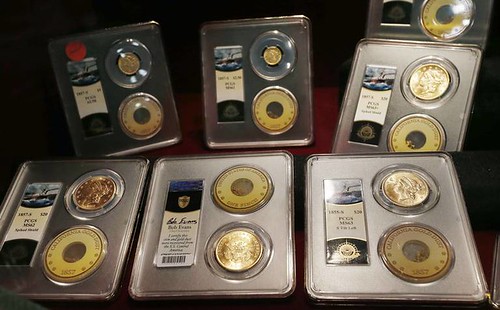
More than 80,000 people attended the annual NRA meeting at the Kay Bailey Hutchison Convention Center. As expected, much of the ballyhoo in the enormous exhibit hall was about assault rifles, revolvers and baseball caps featuring the emblems of numerous gun, knife and sporting goods manufacturers.
But tucked in the back of the exhibit hall was the Ship of Gold exhibit, where visitors gladly posed for photos with the bars, coins and gold dust on display behind glass.
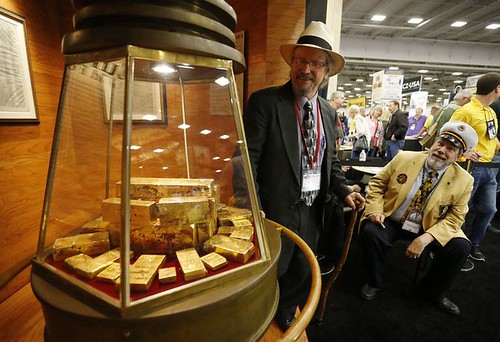
Bob Evans (left) and Mike Fuljenz (right)
Bob Evans, chief scientist aboard one of the missions to retrieve the gold, also was at the NRA meeting in Dallas. He said that even when searchers believed they had located the ship through mathematics, it took weeks to confirm it.
Evans said he knew in his heart that the bounty had been found when a robot sent 7,000 feet under the sea returned to the surface with evidence on its metal parts.. "We found gold dust sediment lodged in the runners of the robot," he said.
To read the complete article, see:
Gold bars and coins worth millions from a ship wreck found at NRA meeting in Dallas
(http://www.star-telegram.com/news/politics-government/national-politics/article210358874.html)

VOCABULARY TERM: STATE
State. Minute differences in struck pieces between earlier and later issues on the same design from the same die (as first, second, etc. state of the die). A stage which can be distinguished from another by a greater or lesser amount of work on the die as a result of RE-ENGRAVING the die, the hub, or even of reworking the model from which a new die would be made. Often the difference is quite minute (as a TOUCHUP or DIE POLISHING after some wearing of the die); or a reissue or later copy would sometimes exhibit greater wear or deterioration (as rusting) of the die.
A careful study of a number of specimens is required to determine the separate stages, and the order in which the die progressed. When discernible, these different stages of the die are, of course, of great interest to
the serious numismatist and makes for one of the more interesting studies in the numismatic field.
CLASS 11.4
6870-(003)05.8
Looking for the meaning of a numismatic word, or the description of a term? Try the Newman Numismatic Portal's Numismatic Dictionary at: https://nnp.wustl.edu/library/dictionary
THE AMERICAN SCHULMAN: HANS M.F. SCHULMAN
John Lupia’s article in last week’s E-Sylum on Jacques Schulman triggered a flood of memories for the American branch of the Schulman dynasty of coin dealers: Hans M.F. Schulman. Hans and I bonded as friends in the late 1950s. remaining so for three decades. Our relationship was professional, personal and social.
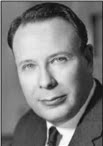 Hans was a cousin of a Jacque Schulman in Holland, undoubtedly a descendent of the Jacques Schulman in John Lupa’s article last week. Hans was born in Amsterdam, coming to America in
1939 ahead of the Nazi occupation of that country. He established his coin dealership in New York City, conducting his first auction sale the following year.
Hans was a cousin of a Jacque Schulman in Holland, undoubtedly a descendent of the Jacques Schulman in John Lupa’s article last week. Hans was born in Amsterdam, coming to America in
1939 ahead of the Nazi occupation of that country. He established his coin dealership in New York City, conducting his first auction sale the following year.
After purchasing numismatic books and primitive money by mail I finally met him in person traveling to NYC while stationed in Washington DC.
I greatly admired Hans and asked him to write a weekly column when I first started Coin World. He traveled to Europe often . We received his columns often from different countries as he traveled about.
Hans had a respect for numismatic literature. He had the policy to purchase several copies of new numismatic books for sale to his customers stocking these on floor-to-ceiling shelves on several rooms of his five-room office suite. He wrote two books: a general book on the field with Hans Holzer, and a coin investment book with Neil Berman.
We enjoyed each other's company occasionally attending Broadway shows together both with his wife Zita, my wife and several times with their daughter.
Throughout his life as a coin dealer he compiled a card catalog much like the one illustrated in last week's E-Sylum, recording the sale price of every coin over $100 value. This continued even after he semi retired, working on it wherever he was. This was testimony to the usefulness of auction records.
Hans died in 1990. It remains for the Dutch Schulmans to continue the family coin dealership dynasty.
To read the earlier E-Sylum article, see:
JACOB "JACQUES" SCHULMAN (1849-1914) (http://www.coinbooks.org/v21/esylum_v21n17a20.html)
HANS MORITS FRIEDRICH SCHULMAN (1913-1990)
 On May 15, 1902, he moved the shop from Amersfoort, Utrecht province, to the north in Amsterdam, Keizersgracht 448, Amsterdam, and the business management was placed under the
direction of his sons Maurits “ (1876-1943), and Geertruida Henrietta van Raalte had a son Hans Morits Friedrich Schulman (May 13, 1913- March 8, 1990), and André (1877-1936), and his son Jacques III (April 6,
1906-April 9, 1991).
On May 15, 1902, he moved the shop from Amersfoort, Utrecht province, to the north in Amsterdam, Keizersgracht 448, Amsterdam, and the business management was placed under the
direction of his sons Maurits “ (1876-1943), and Geertruida Henrietta van Raalte had a son Hans Morits Friedrich Schulman (May 13, 1913- March 8, 1990), and André (1877-1936), and his son Jacques III (April 6,
1906-April 9, 1991).
Maurits and André Schulman had placed their sons Hans and Jacques in the firm at Amsterdam to learn the family business. When each were of age they were sent to Paris to study at the Sorbonne. Jacques seven years Hans senior graduated first and returned to the family business.
 In 1938, Hans Schulman graduated the Sorbonne, Paris, and did not return to the family business as Jacques had done, but rather, left to the United States on the outbreak of the rise of the Nazi regime's
terrorist campaign against Jews. Funded by his father, he opened shop at 545 Fifth Avenue, New York.
In 1938, Hans Schulman graduated the Sorbonne, Paris, and did not return to the family business as Jacques had done, but rather, left to the United States on the outbreak of the rise of the Nazi regime's
terrorist campaign against Jews. Funded by his father, he opened shop at 545 Fifth Avenue, New York.
As Herman Herst, Jr. relates his personal account in Germany at the outbreak of the Nazi regime Jews were forced to convert their wealth into postage stamps in order to get their money out of the country. With Maurits and Hans working with Americans in the New York Stock Exchange and in the new coin shop in New York it gave the Schulmans leverage during WWII.
On July 2, 1943, Morits Schulman died. With Hans in New York it left his nephew, Jacques Schulman III to serve as the business manager.
To read the complete article, see: SCHULMAN, (https://sites.google.com/a/numismaticmall.com/www/numismaticmall-com/schulman-jacques)
The entire inventory of the Lupia Numismatic Library is for sale. Individual items will be available before the remaining archives are broken up into parcels sold at philatelic auctions in the U. S. and Hong Kong. Check NumismaticMall.com frequently as dozens of new items with estimates will be posted daily until everything is sold.
All inquiries will be given prompt and courteous attention. Write to: john@numismaticmall.com .

HARVEY STACK'S NUMISMATIC FAMILY, PART 17
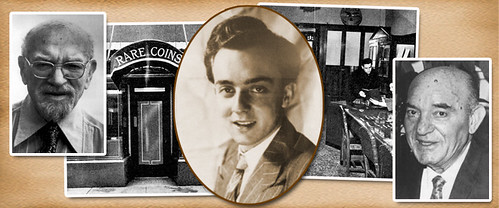
With the sale of the Davis Graves cabinet successfully concluded, the firm went "full speed ahead" to catalog the Anderson Dupont Collection.
The Anderson Dupont Collection of United States copper, nickel and silver coins was one of the most comprehensive collections of U.S. silver and copper coins to be offered on the auction market for years. At first, the U.S. gold in the Anderson Dupont Collection was not scheduled to be in the sale (this will be explained later).
The collection was of extreme size and reflected an attempt by the collector to encompass the earliest dates of our Mint until the mid 1930s. It contained varieties and rare dates, in nice circulated condition, Mint State and Proof.
The first part of the Anderson Dupont Collection contained United States large cents. The collection presented 1,000 dates and varieties from 1793 to 1857. It contained many high quality and rare examples, explaining why Dr. William Sheldon was willing to catalog it. This collection alone provided much information as to rarity and quality. To me, working directly with Dr. Sheldon and his helper C. Douglas Smith was a college course on grading cents and identifying varieties. The Anderson Dupont Collection contained coins that were acquired from collections that had been sold over the previous 50 years or more. These coins had not previously been available for study.
To give an idea as to the scope of the collection there were 19 cents of the 1793 Chain and Wreath types, 75 cents dated 1794, and a total of 344 dates and varieties from 1795 to 1814 and followed by 784 later dates of the 1816 through 1857 range. Many were of Condition Census quality and others were among the best known of certain varieties with a large number in Mint State or Proof.
The large cent portion of the Anderson Dupont Collection was sold in September 1954. Dr. Sheldon did a fine job of cataloging the coins, and our photographer Sam Andre did a great job in capturing the details of the coins. We had a large group illustrated on full page photo plates within the catalog. Once Dr. Sheldon revealed in detail what was forthcoming in the offering, excitement developed rapidly within the huge community of cent collectors. In fact, some established cent collectors tried to make plans to determine who would “win” many of the lots. We needed extra time and people to show lots, as well as time to discuss some of the new information that appeared in the auction catalog. The catalog quickly became a new reference book.
The evening the large cents were offered, the auction room filled up quickly with some 300 seated collectors and standing room only for the balance of those attending. It was noted by me (I was to be a "spotter" for my uncle, who was the auctioneer) that an unfamiliar but lovely lady came into the room and seated herself next to the side door to the auction room. Before the sale started, my secretary came running over to me, said that the young lady was to be bidding with the initials D.N. -- we used initials at the time not bidder numbers -- and told me that she had left a substantial deposit and was planning to bid on a number of the cents. Wow, a new bidder, unknown to anyone, could only add to the great competition we were anticipating.
When the sale started, Dr. Sheldon sat on the side aisle with some dozen or more collectors near him. When the bidding started, Dr. Sheldon seemed to orchestrate the bidding, and his side of the room bid to a certain level and then stop. The auctioneer was still looking for more bids. It seemed that at a certain level only one bidder from the Sheldon group was bidding. Suddenly from the other side of the room "D.N" bid, and continued bidding until the Sheldon side stopped. She won the lot and did the same thing on a number of the 1793 cents. As we got to the extensive group of 1794 cents, she selected certain scarce or choice examples and topped the other bidders. Any plans that the group of collectors sitting with Dr. Sheldon had made with each other were foiled and each was on his own against the mystery lady. The combination of the quality of the material and a “wild card” bidder led to record-making prices in both sessions. Those of us in the room were able to see history being made.
To read the complete article, see:
Harvey Stack Remembers: Growing up in a Numismatic Family, Part 17 May 2, 2018
(http://www.stacksbowers.com/News/Pages/Blogs.aspx?ArticleID=2948)
To read the earlier E-Sylum article, see:
HARVEY STACK'S NUMISMATIC FAMILY, PART 16 (http://www.coinbooks.org/v21/esylum_v21n16a27.html)
DON EVERHART AND THE DALAI LAMA
During my 13+ years as a sculptor-engraver for the United States Mint, I had the opportunity to work on Congressional Gold Medals for many prominent leaders and heads of state. Additionally, I had the honor to work on two Presidential Medals.
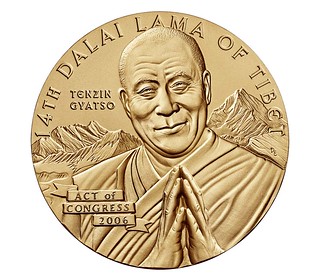 One of my favorite Congressional Gold Medals (CGMs), however, was for the Dalai Lama. I designed the obverse and actually got to meet His Holiness.
One of my favorite Congressional Gold Medals (CGMs), however, was for the Dalai Lama. I designed the obverse and actually got to meet His Holiness.
The CGM Ceremony was held in the Capitol Rotunda in February of 2007. Several members of the Mint staff were invited to meet with His Holiness in his hotel suite before the ceremony. My boss, John Mercanti, and Ed Moy, the Director of the Mint, accompanied us to the much-anticipated meeting. It was THE hot ticket!
We all sat in a circle with the Dalai Lama to my immediate left. Everyone spoke briefly to him and when it got around to me I mentioned that I had gotten quite a feeling of serenity when working on this medal, which I directly attributed to him. He leaned forward to speak to me and I expected to hear the secret to eternal happiness. Instead he asked “Did you give me hair?” while brushing the top of his head. I assured him that I did. We all had a laugh and then proceeded to talk about male pattern baldness.
To read the complete article, see:
Don Everhart: My Career in Coins, Part 3 – Historic Figures & Heads of State
(https://coinweek.com/us-mint-news/don-everhart-my-career-in-coins-part-3-historic-figures-heads-of-state/)
To read the earlier E-Sylum excerpts, see:
DON EVERHART AT THE FRANKLIN MINT (http://www.coinbooks.org/v21/esylum_v21n14a18.html)
DON EVERHART AT THE U.S. MINT (http://www.coinbooks.org/v21/esylum_v21n16a10.html)
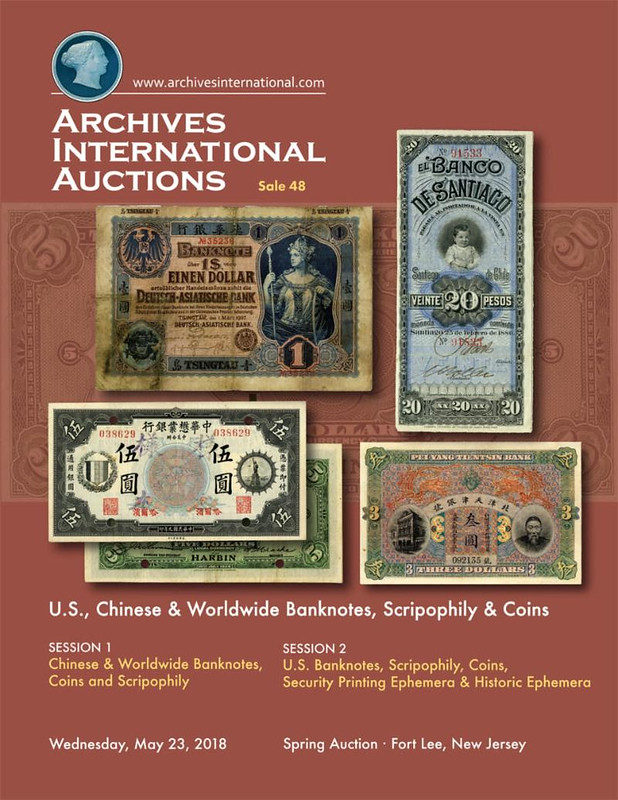
TRAVEL ARTICLE HIGHLIGHTS YAP STONE MONEY
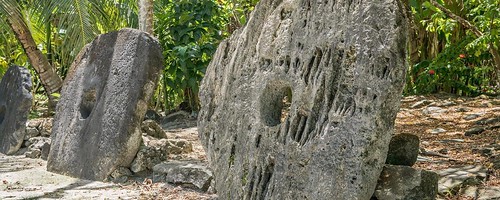
Arriving on the tiny Micronesian island of Yap will fill even the most jaded traveller with a sense of awe. The single daily flight comes in over dense forests, taro swamp, shallow lagoons and a web of mangroves, all surrounded by fringing reef. But the real wonderment doesn’t come from the idyllic scenery, nor from the greeting by a Yapese girl in a traditional hibiscus skirt. It’s when you first come face-to-face with a piece of giant stone money.
Hundreds of these extraordinary, human-sized discs of rock are scattered all over the island; some outside the island’s few hotels, others in rows close to the beach or deep in the forests. Each village even has a stone money bank where pieces that are too heavy to move are displayed on the malal (dancing grounds).
“My family owns five stone money of a good size,” said Falmed (Yapese just use one name), a taxi driver I flagged down to take me to Mangyol stone money bank in Yap’s eastern province of Gagil.
Five, it turns out, is a good haul, since many islanders don’t own any stones.
The unique stone currency has been in use here for several centuries, although no-one is quite certain when the concept began. What is known is that each one is different, and they are as heavy with meaning as they are in volume of limestone, carved and voyaged by the Yapese all the way from Palau, an island nation 400km to the south-west.
On their return from Palau, the sailors would give the carved stone money to the high chiefs who would gather from different villages to welcome back the sailors and the stones. The chiefs would keep the larger ones and two fifths of the smaller ones. They would also give names to some stones, usually choosing their own name or that of relatives, and confirm the stones as legitimate by giving a value based on an even older currency system: yar (pearl shell money). The stones could then enter circulation and be bought by anyone.
“If the chief says OK, 50 shell money for each stone money, if I have that I will make the trade and own one,” explained Edmund Pasan, a canoe builder from the northern province of Maap.
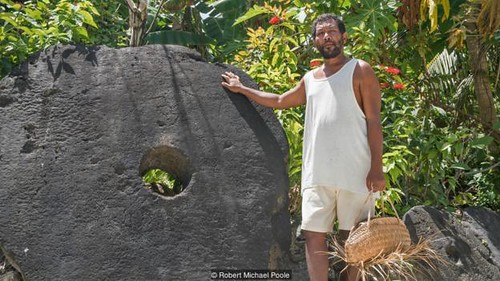
Today, shell money has been replaced by the almighty US dollar for day-to-day transactions like grocery shopping. But for more conceptual exchanges, like rights or customs, stones remain a vital currency for Yap’s 11,000 residents.
Falmed’s family has only used its money twice, and one was as an apology. “We used it for one of my brothers who made trouble for another family,” Falmed revealed remorsefully. His brother’s marriage had failed. “One of the chiefs, his daughter got one piece of stone money as an apology, and they accepted it. When it comes to high ranks, you have to use stone money.”
To read the complete article, see:
The Tiny Island With Human-Sized Money (http://www.bbc.com/travel/story/20180502-the-tiny-island-with-human-sized-money)
EUCOPRIMO: PRIMITIVE MONEY ORGANIZATION

EUCOPRIMO is an organization I was invited to join while we lived in Germany the past two years. It is boasts over 200 members from the European Countries and North America. Meetings are twice a year, I have been to four meetings so far, Friday night to Sunday morning, always at different locations in Germany so as to visit as much history as possible each time.
It truly makes for a refreshing weekend, seeing such a variety of weird and wonderful things and talking with experts about them. We came home with some Ethiopian Gold Jewelry and a Meso-American Jade-stone necklace. There were few coins, but many Trade Beads, Gold Weights, Bride-Price items, Weaponry and more.
From The Articles of Association:
"The Association pursues the objective to explore the cultural heritage of exceptional forms of money and to spread and exchange professional information among members. It aims to promote knowledge of original and unusual forms of money...The Association pursues exclusively charitable purposes through the selfless promotion of this topic."
EUCOPRIMO issues a bi-yearly magazine "The Primitive Money Collector" in conjunction with the meetings. This is a platform for the dissemination of knowledge and information and is supplemented by collaboration with Universities, Museums and Connoisseurs of countries of origin. The magazine has a wide range of topics, from Pacific Coast Shell money to African Knife money, to Carved Stones and Jewelry.
The Organization was formed in 1978, and its members come from diverse backgrounds: Numismatists, Ethnologists, Art Collectors,and Jewelry collectors. At the meeting last month, there were about 65 members who spent a very enjoyable weekend together, seeing the local museum, participating in the Borse (private Coin Show) and Auction and discussing learned and unlearned topics...And a good time was had by all.
For more information, see:
http://www.eucoprimo.com/
READY REPLICAS AND MONEY MAGIC
The April/May 2018 issue includes an article by Henry Flynn discussing an exhibit at the British Museum highlighting interesting lesser-known numismatic collections around the U.K. The article covers six institutions. Here's an excerpt covering two of them. The first involves Ready electrotypes, discussed recently in The E-Sylum. -Editor
The selection includes a local history museum in Scotland, a stately home in the North West of England, an 18th century library in Northern Ireland, a military museum in Wales and both a national and independent museum in London. This reflects the extent of the Network itself but also illustrates the range and diversity of numismatic collections that are available for the public to see.
The Science Museum
Katy Barrett, Curator of Art Collections
The Science Museum collections include a set of 7 frames of electrotype coins arranged in periods, BC 700- BC 1. They are copies of coins in the British Museum produced initially for the V&A and in the collections there from 1894. The set was most likely produced in the 1860s in response to the initiative of V&A director Henry Cole to make heritage available internationally through copies. The Ready family – father Robert, and later sons Charles Joseph and Augustus Papworth – worked for the British Museum making such copies from the 1860s.
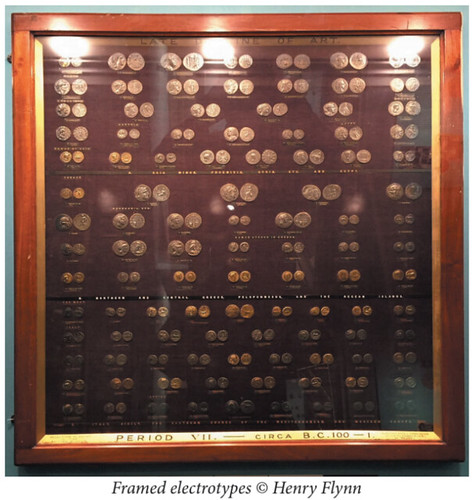
In their first guise at the V&A, these electrotypes demonstrated the ‘decline’ of art in the design of Greek coins. Transferred to the Science Museum in 1946 they represented an example for the metallurgy collections of the electrotype process. Later they moved to the Coins, Medals and Tokens collection, joining an important group of material that reflects the role of these objects in the history of science, technology and medicine. This includes coin production, and industrial tokens, as well as commemorative and award medals.
To read the earlier E-Sylum article, see:
ROBERT READY’S BRITISH MUSEUM REPLICAS (http://www.coinbooks.org/v21/esylum_v21n11a12.html)
The Magic Circle Museum
Scott Penrose, Executive Curator, The Magic Circle Museum
It is interesting to compare more general numismatic collections with those held at institutions with a specialist remit. An excellent example of such an institution is The Magic Circle Museum in London. A selection of objects, giving a sense of what our collection is comprised of, has been loaned to the exhibition.
Numismatics and the performance of magic are inextricably linked. This is represented in the exhibition through the display of objects relating to two performers, Thomas Nelson Downs and Mercedes Talma, who were so adept at coin tricks that they became known as the ‘King of Koins’ and ‘Queen of Coins’ respectively.
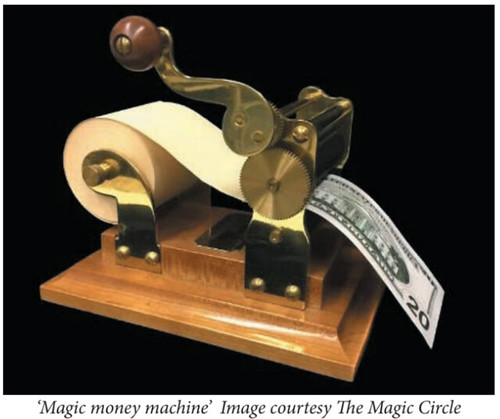
No display of magical numismatic objects would be complete without some coin tricks. To this end, a ‘Cabinet of Coin Tricks’ set, dating to about 1920, has been loaned to the exhibition. It is a small red folder containing six prop coins for conjuring use. Under our express instructions, the folder has been displayed closed to ensure that no secrets can be revealed.
One of the most intriguing objects in this display is the Magic Money Machine, a prop produced around 1990. When the crank handle is turned, a roll of blank paper is seemingly transformed into real banknotes. This has proven to be one of the most popular objects in the display with both visitors and staff at the British Museum.
For more information on the Money & Medals Network, see:
http://www.moneyandmedals.org.uk/

STACK'S BOWERS 2018 ANA SALE HIGHLIGHTS
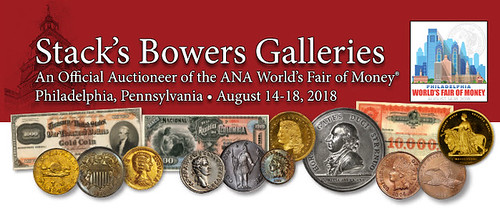
In August 2018, Stack’s Bowers Galleries will host an official auction in support of the most popular collector’s organization in the hobby, the American Numismatic Association. Our official auction at the 2018 Philadelphia World’s Fair of Money has already become a star-studded event, as illustrated by the collections and highlights featured here. As thousands of dealers, investors, and collectors gather for the most heavily attended convention of the year, you can be confident that this will be the most favorable time to realize top market price for your U.S. and world coins and paper money. Featured will be:
• The Finest Known 1913 Nickel Proof-66 (PCGS)
• The Joel R. Anderson Collection of Large Size United States Paper Money
• The ESM Collection of Flying Eagle and Indian Cents
• The John Whitney Walter Collection
• The Cardinal Collection
• The Rosie Collection
• The Eldorado Collection of Colombian Coins and Paper Money
• The Blue Ridge Mountain Collection
• The John E. Herzog Collection of U.S. Treasury Bonds - 1861 to 2000
The Joel R. Anderson Collection of Large Size United States Paper Money
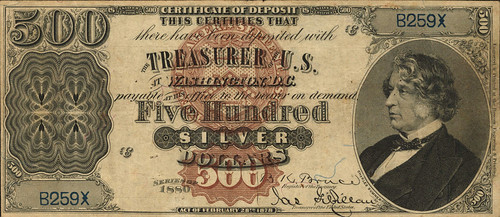
Fr. 345c. 1880 $500 Silver Certificate.
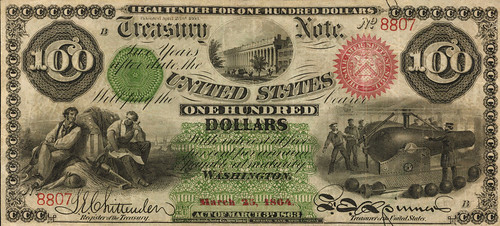
Fr. 204. 1863 $100 Interest Bearing Note.
The ESM Collection of Flying Eagle and Indian Cents

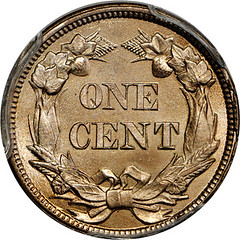
The John Whitney Walter Collection
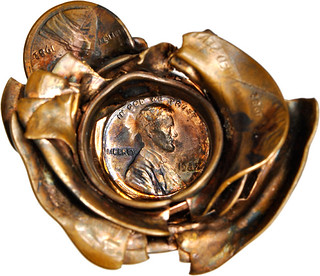
The Cardinal Collection

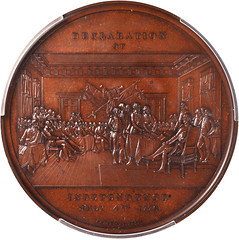
Declaration of Independence Signing Ceremony Medal
The Rosie Collection
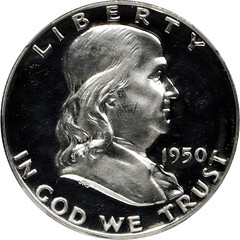
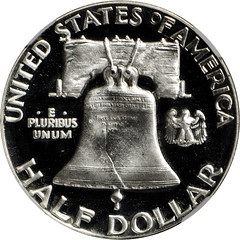
The Eldorado Collection of Colombian Coins and Paper Money
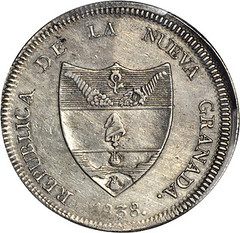
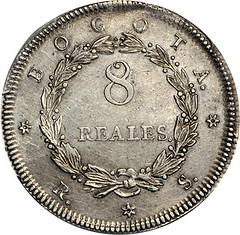
Unique 1838-RS 8 Reales
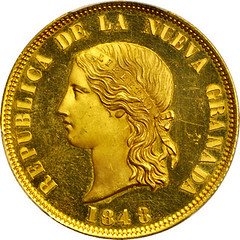
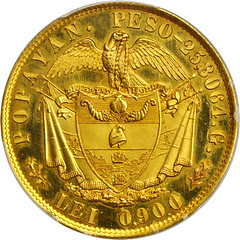
1848 Pattern 8 Pesos of Popayán in Gold
The John E. Herzog Collection of U.S. Treasury Bonds - 1861 to 2000
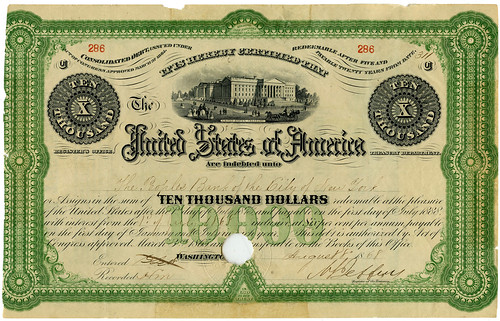
United States of America. August 8, 1868. $10,000 Registered Bond.
To read the complete Stack's Bowers 2018 ANA Auction Brochure, see:
http://media.stacksbowers.com/SBG_eblast_images/2018/
ANA2018/SBG_ANA2018_Brochure.pdf
MEDALS FROM NUMISMAGRAM: PLANES AND TRAINS
ITALY. Aero Club d'Italia Medal
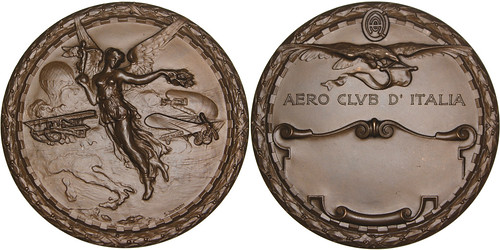
ITALY. Bronze Award Medal. Issued circa 1925. For the Aero Club d'Italia (70mm, 148.04 g, 12h). By Stefano Johnson in Milan. Personification of Victory flying left, head right, holding victoriola and wreath; in background, biplane and hot air balloon to left, monoplane and dirigible to right; at ground level, outline of Italy, Sicily, and Sardinia; all within chorded and wreathed border / AERO CLVB D'ITALIA, eagle facing in flight, with banner in beak, club logo above, cartouche for inscription below; all within chorded and wreathed border. Edge: Plain. Gem Mint State. Charming red-brown surfaces, exceptional artistry and relief. A large and impressive piece.
Highly detailed and ornate, this attractive unengraved award medal was created by Stefano Johnson, known to US collectors for his series Columbian Expo medals—intensely beautiful issues in their own right.
To read the complete item description, see:
100315 | ITALY. Bronze Award Medal (http://numismagram.com/product-page/100315)
ETHIOPIA. Ethio-Djibouti Railway Medal
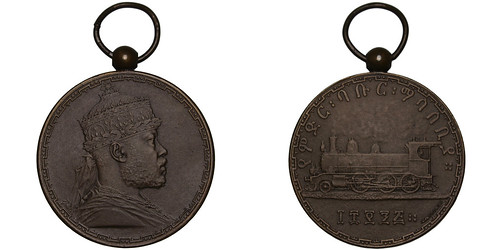
ETHIOPIA. Menelik II bronze Medal. Dated EE 1895 (1903). Commemorating the Opening of the Ethio-Djibouti Railway (32mm, 16.32 g, 12h). By J. C. Chaplain and H. Patey in Paris. Crowned and draped bust right / Steam locomotive left. Edge: Plain; with ball suspension and suspension ring. Barac 4; Gill M41. Choice Mint State. Pleasing matte brown surfaces. Attractive and interesting.
The railway between Djibouti City (in Djibouti) and Dire Dawa (in Ethiopia) was completed in 1903, allowing for a rapid expanse in the former and a virtual French enclave in the latter. Further expansion to the line included the eventual terminus at the capital of the Ethiopian empire, Addis Ababa, 784 km (487 miles) inland from the Port of Djibouti.
To read the complete item description, see:
100325 | ETHIOPIA. Menelik II bronze Medal. (http://numismagram.com/product-page/100325)
NUMISMATIC NUGGETS: MAY 6, 2018
Marcus Aurelius Gold Aureus
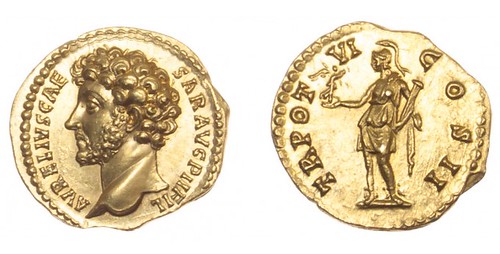
Marcus Aurelius (AD 161-180)
Gold Aureus, Rome AD 151-152.
Obverse: Bareheaded bust of Marcus Aurelius facing left, AVRELIVS CAESAR AVG PII FIL. Reverse: Roma standing left, being crowned by victory standing in her right hand, TR POT VI COS II.
Good extremely fine with much original lustre, particularly high relief portrait of exceptional style.
RIC 452d. Calico 1942)
7.18g.
Ex SNC, October 2000, Lot #4055
The renowned philosopher emperor appears in spectacular artistic form on this impressive gold aureus minted in Rome. The coin bears an unusual left-facing portrait of the young prince – at this time, Caesar under Antoninus Pius. His portrait appears somewhat in the style of his heir, who would die a decade after this coin was struck, heralding the reign of Marcus Aurelius as emperor. The dies used to produce this marvellous coin are of notable artistic merit, engraved to an impressive depth. This combined with a brilliant central strike has created a gold piece of fantastic high relief.
To read the complete item description, see:
Marcus Aurelius, Gold Aureus Item Reference: KM60155 (https://www.baldwin.co.uk/marcus-aurelius-av-aureus-km60155.html)
1528 Joachimsthal Silver Medal

Silver medal 1528. Pest valley. Münzmeisterzeichen Crescent with cross of the master Utz Gebhart in Joachimsthal. The brass strike, pages 15-Z8 and NVM - RI.21 and six kneeling persons each, four persons lying at the foot of the cross. Rv. Christ on the Cross, on the pages of the Cross IOAN - NES.3., Six pages each on the sides. 47.1 mm. 28.89 g. Katz 8. Good very nice / Good very fine. Handle trace / Mount mark
To read the complete item description, see:
Lot 1332 Silver medal 1528. Pest valley
(/auktionen.sincona.com/Auktion/Onlinekatalog?intAuktionsId=574#ankercphMain_cphMain_auktion_losFilter_ebene0)
1786 Silver Medal of Frederick II
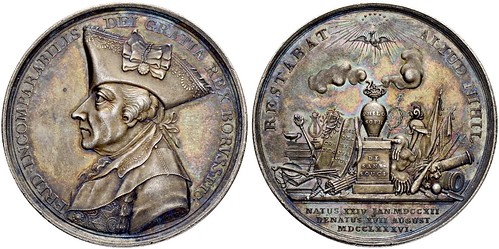
Frederick II. 1740-1786. Silver medal 1786. On his death. Stamp by JG Holtzhey. Half-length portrait in uniform with tricorn to the left. Rv. Crowned urn on pedestal, around war and peace symbols. 25.44 g. Olding 753 a. Excellent FDC / Extremely fine-uncirculated.
To read the complete item description, see:
Lot 1316 Frederick II. 1740-1786. Silver medal 1786.
(/auktionen.sincona.com/Auktion/Onlinekatalog?intAuktionsId=574#ankercphMain_cphMain_auktion_losFilter_ebene0)
1908-O Barber Dime
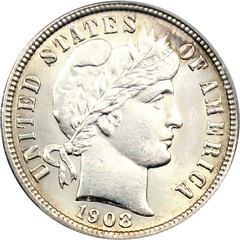
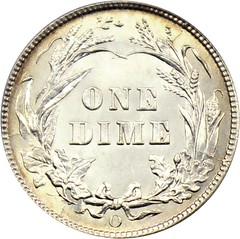
To read the complete item description, see:
1908-O 10c PCGS MS64 (https://www.davidlawrence.com/rare-coin/1374752)
Inglourious Basterds Movie Money
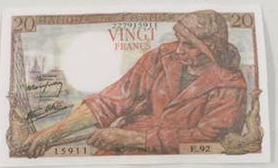
Faux France Antique Paper Money.
To read the complete item description, see:
Inglourious Bastards Currency Movie Props
(https://www.barnebys.com/auctions/lot/469095379/inglourious-bastards-currency-movie-props/)
For more information on the film, see:
Inglourious Basterds (2009) (https://www.imdb.com/title/tt0361748/)
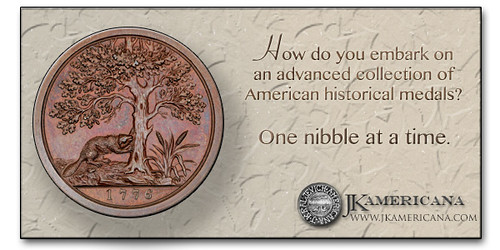
JEWISH BAR KOKHBA REVOLT COIN FOUND IN CAVE
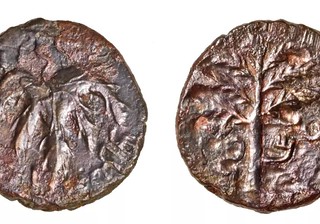 A rare coin from the Bar Kokhba revolt was discovered in the Qibya cave, 30
km northwest of Ramallah, the Coordination of Government Activities in the Territories announced Thursday.
A rare coin from the Bar Kokhba revolt was discovered in the Qibya cave, 30
km northwest of Ramallah, the Coordination of Government Activities in the Territories announced Thursday.
The coin is believed to have been minted between the third and fourth year of the Bar Kokhba revolt (136-134 CE).
One side of the coin shows a palm tree with seven fronds and two clusters of fruit, as well as the inscription “Shim[on].” The other side portrays vine leaves with three lobes and the inscription, “To the freedom of Jerusalem.”
Alongside the coin, the archeologists also found pottery fragments and glass vessels that can be dated to the same period.
Experts estimated that the items were brought to the cave by Jewish refugees who lived in the area until 135 BCE. During the Bar Kokhba revolt, they were forced to leave their homes and hide in the cave.
To read the complete article, see:
RARE COIN FROM ANCIENT JEWISH BAR KOKHBA REVOLT DISCOVERED IN CAVE
(https://www.jpost.com/Israel-News/Rare-coin-from-ancient-Jewish-Bar-Kokhba-revolt-discovered-in-cave-553384)
WWI MEDAL RETURNED TO SOLDIER'S FAMILY
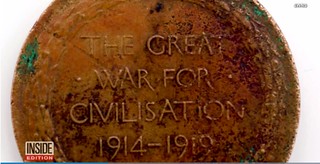 More than a century after 24-year-old A.G. Hammond was killed on the
Western Front, a World War I medal issued to him has been given to his granddaughter.
More than a century after 24-year-old A.G. Hammond was killed on the
Western Front, a World War I medal issued to him has been given to his granddaughter.
The Freedom Medal had been dug up by Mike Iacovelli in the 1980s, when he was a 9-year-old child looking for hidden treasure in his back yard in Worcester, Great Britain.
He convinced his mum to take to him to Worcester Museum to ask after the medal. He had scrubbed it clean and discovered "The Great War for Civilisation -1914 - 1919" inscribed on its surface, along with "A.G. Hammond."
At the museum, he was told it was a Freedom Medal posthumously awarded to Hammond after the Great War. It had been sent to his widow in Worcester and somehow ended up in a field outside the city.
The boy put it in a tin box where he kept his treasures and over the years, forgot about it.
He emigrated to Toronto and 2004 and took the box with him. Recently, he showed it to his three sons, and was prompted to try to find the family of Arthur George Hammond, who was a gunner in the 61st Division's ammunition column.
Eventually, the medal made its way to Carol Griffiths, 75, Hammond's granddaughter. She lives just 300 yards from where the medal was found.
"It is a one in a million find and I am thrilled to have the medal back in the family. Although I never met my grandfather having the medal which was awarded to him is wonderful," she said.
To read the complete article, see:
Man Who Dug Up WWI Medal As a Child Returns It to Soldier's Family
(https://www.insideedition.com/man-who-dug-wwi-medal-child-returns-it-soldiers-family-42986)
CURRIE VICTORIA CROSS TO STAY IN CANADA

For his skill and leadership Canadian Major David Vivian Currie of the South Alberta Regiment was awarded the highest honour for valour, the Victoria Cross. Later promoted to LCol, Currie always siad he was simply doing his job and the medal wasn’t for him, but rather an honour to all those who didn’t come back.
He died in Owen Sound, Ontario in 1986 and the medal was sold by his widow in 1989. It was again auctioned to a British buyer last year for $550,000, plus a $110,000 auction house fee.
Held up by Canadian laws regarding export of heritage items, that historic medal has just been purchased back from the buyer and will now remain in Canada.
The medals will be on display at the Canadian War Museum.
The purchase price to ensure the medal remained in Canada was not revealed, but was made possible by the generous support of the Movable Cultural Property Program of the Department of Canadian Heritage, the Museum’s donor-supported National Collection Fund, and generous contributions from the Brownlee Family Foundation, as well as the following honorary members of the North Saskatchewan Regiment and their families: Heather Ryan and L. David Dube, Honorary Lieutenant-Colonel; Sandra Howe and Dallas Howe, Honorary Colonel; Sandra Stromberg and Robert Stromberg, former Honorary Colonel. The Canadian Cultural Property Export Review Board deemed the medal to be “of outstanding significance and national importance,” helping to pave the way for the Museum’s acquisition
To read the complete article, see:
Hero’s Victoria Cross to stay in Canada (http://www.rcinet.ca/en/2018/05/02/heros-victoria-cross-to-stay-in-canada/)
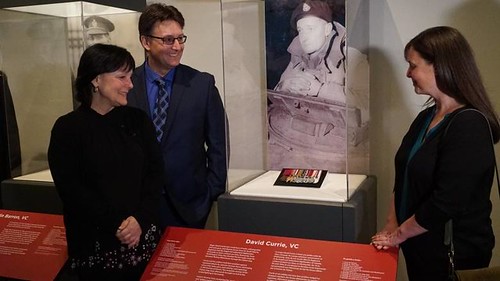
The only Victoria Cross awarded to a Canadian who fought in Normandy is now in the hands of the Canadian War Museum.
"The Canadian War Museum is proud to have been a part of the effort to keep this important piece of our military heritage in Canada for the benefit of present and future generations," said Mark O'Neill, the museum's president and CEO in a release.
"It is inspiring to see how many Canadians have come forward to help. We are profoundly grateful for government support and for the private donations that enabled us to acquire the Currie medal set."
His Victoria Cross marks the 38th such medal in the possession of the Canadian War Museum. Only 99 of the medals have been issued to Canadians.
The museum said Currie's Victoria Cross and two other significant medals will be on display until May 29.
To read the complete article, see: Canadian War Museum steps in to save Victoria Cross (http://www.cbc.ca/news/canada/ottawa/ottawa-war-museum-victoria-cross-1.4643916)
To read the earlier E-Sylum article, see:
CURRIE CANADIAN VICTORIA CROSS SALE REVIEW (http://www.coinbooks.org/v20/esylum_v20n49a34.html)
OSS WWII VET RECEIVES CONGRESSIONAL GOLD MEDAL
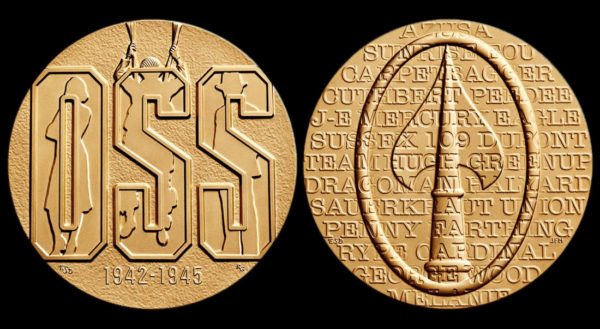
After seventy-five years, twenty of the surviving one-hundred World War II veterans made the trip to Washington D.C. on a snowy day in March. Representing those that served the Office of Strategic Services (OSS), they received the nation’s highest civilian honor, the Congressional Gold Medal.
A precursor to the Central Intelligence Agency (CIA), the OSS was a wartime intelligence agency of the United States during WWII formed to coordinate espionage activities behind enemy lines for all branches of the United States Armed Forces.
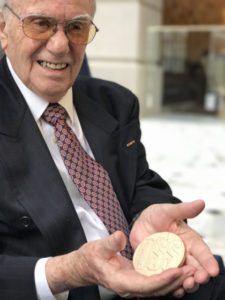 Oakland, California native Andrew Mousalimas was one of those heroes in
attendance. “It was thrilling to receive the coveted Congressional Gold Medal,” said Mousalimas, now 93. He was just 18 when he and four of his California childhood friends (Nick Cominos, Tom Georgalos, Alex Phillips, Perry
Phillips) joined a special battalion of Greek American descent. The Greek/American Operational Group (aka Greek/USOG) was part of the Ethnic Operational Groups which also included France, Italy, Norway, and Yugoslavia. There
were also USOGs in Burma and China.
Oakland, California native Andrew Mousalimas was one of those heroes in
attendance. “It was thrilling to receive the coveted Congressional Gold Medal,” said Mousalimas, now 93. He was just 18 when he and four of his California childhood friends (Nick Cominos, Tom Georgalos, Alex Phillips, Perry
Phillips) joined a special battalion of Greek American descent. The Greek/American Operational Group (aka Greek/USOG) was part of the Ethnic Operational Groups which also included France, Italy, Norway, and Yugoslavia. There
were also USOGs in Burma and China.
Their multi-faceted mission, as noted by the U.S. Army Special Operations Command, was to organize, train, and equip local resistance organizations, and to conduct ‘hit and run’ missions against enemy-controlled roads, railways, and strong points, or to prevent their destruction by retreating enemy forces.
His unit worked with British commandos and Greek partisans, and their heroism was not revealed until more than 45 years after their last battle, reported the San Francisco Chronicle. “It was one of the best kept secrets of war,” Mousalimas said. “The unit confirmed in my lifetime what determination and devotion was to duty. These guys (Greek/USOGs) were the toughest men and best-trained unit in the Army.”
On March 21, 2018, the leaders of the U.S. House and Senate presented a Congressional Gold Medal in honor of the members of the OSS for their extraordinary contribution to victory in WWII. “They passed on a sense of duty and daring to today’s intelligence professionals,” remarked House Speaker Paul Ryan (R-WI). “They preserved the spirit of freedom of our children. And so: for the men and women of the OSS, those glorious amateurs who struck a decisive blow to fascism, the United States Mint has struck a Gold Medal, which we present now on behalf of a grateful nation.”
To read the complete article, see:
OSS WWII Veteran Andrew Mousalimas receives Congressional Gold Medal
(https://www.hellenicjournal.org/oss-wwii-veteran-andrew-mousalimas-receives-congressional-gold-medal/)
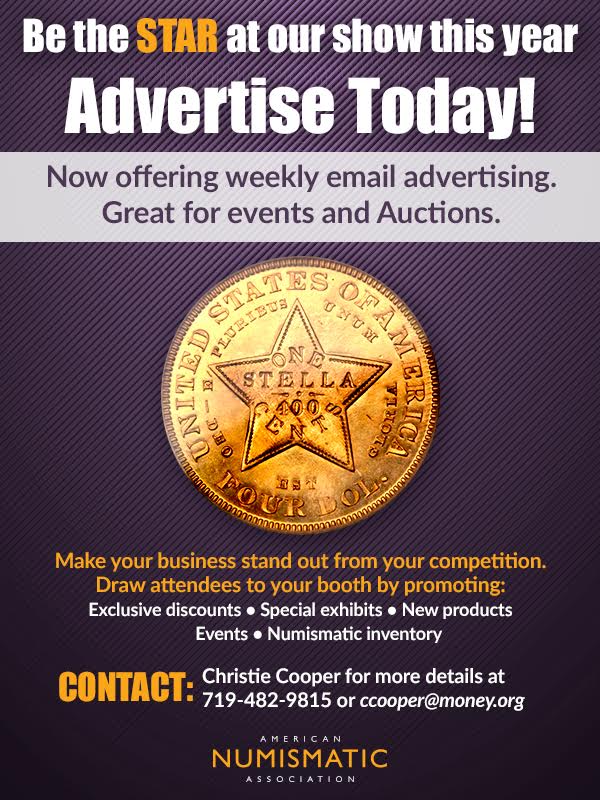
WHY BITCOIN WON'T WORK
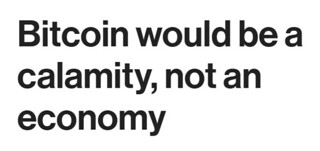 The number of Bitcoin transactions (as opposed to trades) has not risen much in the last few years, and one recent academic study suggested that
half of those transactions are associated with illicit activity. As a medium of exchange, Bitcoin remains today pretty much what it was in 2010: an interesting complement to the existing monetary system, primarily useful for
people interested in avoiding legal authorities or living in societies racked by inflation (like, say, in Venezuela or Zimbabwe).
The number of Bitcoin transactions (as opposed to trades) has not risen much in the last few years, and one recent academic study suggested that
half of those transactions are associated with illicit activity. As a medium of exchange, Bitcoin remains today pretty much what it was in 2010: an interesting complement to the existing monetary system, primarily useful for
people interested in avoiding legal authorities or living in societies racked by inflation (like, say, in Venezuela or Zimbabwe).
Still, the dream that cryptocurrency could replace our existing system of fiat money, in which the money supply is controlled by government-run central banks, remains a key part of Bitcoin’s appeal. The promise is of a system where the government can’t manipulate the money supply, and market competition determines which currencies people use. But what would happen if that dream came true? If the dollar and the euro were replaced by Bitcoin, how would the system adapt, and how would the economy and the financial system function?
The simple answer is: not well. Our economies and financial systems are built around fiat money, and they rely on the central bank’s control of the currency (and the government’s ability to issue debt in that currency) to help manage the business cycle, fight unemployment, and deal with financial crises. An economy in which Bitcoin was the dominant currency would be a more volatile and harsher economy, in which the government would have limited tools to fight recessions and where financial panics, once started, would be hard to stop.
The opposite of what you want
To see why this is the case, it’s key to recognize the crucial role that the central bank (which in the US is the Federal Reserve) plays to provide what economists call “liquidity” when the system needs it. That’s just a
fancy way of saying that the central bank can pump money into the system, either by printing it and then lending it to banks (with the idea that they will then inject that money into the system) or by simply buying assets
itself. Providing liquidity is especially important in times of financial crisis, because crises lead banks to cut back on lending and savers to pull their money out of banks. In those times, the central bank serves as a
lender of last resort, stepping in when otherwise solvent banks are struggling to stay afloat and ensuring that we don’t end up with a flood of bank closings.
In an economy run on Bitcoin, these things would be impossible for a central bank to accomplish.
To read the complete article, see:
Bitcoin would be a calamity, not an economy
(https://www.technologyreview.com/s/610783/bitcoin-would-be-a-calamity-not-an-economy/)
BASIS: THE STABLE CRYPTO-COIN

Cryptocurrencies came into being with an anti-bank fervor that still runs hot in the technology community. Libertarians see Bitcoin and the rest as an alternative to fiat money controlled by financial institutions and the government. But the quest to create a cryptocurrency with a stable $1 value—a so-called “stable coin”—has startups acting like banks.
For cryptocurrencies, extreme price volatility remains a huge problem and has already caused some big players to back off. For example, volatility was cited by mobile payment company Stripe in its decision to drop support for Bitcoin in January, and by Steam (the largest online retailer for video games) when it did the same in December.
It’s easy to understand why. The dollar value of one bitcoin today can’t be counted upon for tomorrow, either because the price skyrockets unpredictably, or it suddenly tanks. The first scenario isn’t a problem for most people, but the second is dangerous for any business holding cryptocurrency, which may suddenly find that it traded real goods for worthless digital tokens. All of the other problems with Bitcoin and cryptocurrencies writ large—that they’re inefficient, expensive, and so on—pale in comparison to the simple fact that nobody wants to use money they can’t depend on.
The creation of a “stable coin,” a cryptocurrency that can hold its value and be used as a digital stand-in for the US dollar, has long been seen as an innovation as fantastical and mythic as the holy grail of Arthurian legend. Now, several startups are pursuing this goal with varying levels of success and big names in tech are paying attention. Last week, New York City-based startup Intangible Labs announced that it received a $133 million round of funding from big-name investors like Bain Capital and GV, Google’s venture capital arm, to create a stable coin called Basis.
Stable coins claim to solve some of the biggest issues with cryptocurrencies today, so it’s no surprise they’re attracting interest and investment—even if the startups behind them are acting a bit like banks did in the literal Wild West by issuing currencies backed by their own assets, or like central banks today by managing money supply. According to experts I spoke with, it all seems too good to be true.
How is a stable coin supposed to work?
Stabilizing a coin means finding creative ways to tame the market dynamics that make Bitcoin and other cryptocurrencies so volatile. So far, that’s made the startups attempting to do so look a lot like banks—because they’re
either issuing a digital notes backed by their own assets, or manipulating supply like a central bank does.
The first approach to stabilizing a cryptocurrency is what Song described in our phone call as the “we have the money” method.
Imagine that Scrooge McDuck wanted to stick it to the US government and issued his own banknotes like it was the 1800s. One DuckBuck is equal to one gold coin stored in Scrooge’s personal vault, and can be redeemed at any time. Everyone in Duckburg has seen Scrooge diving into his mountain of gold in his skivvies, and so everyone knows that Scrooge is good for it. Thus, everyone trades DuckBucks safe in the knowledge that one DuckBuck will equal one gold coin for as long as Scrooge has a pile of gold.
Other approaches to creating a stable coin, Song said over the phone, are “even more similar to central banking except they’re using market forces to [stabilize the coin] and they have all sorts of incentives.”
The best example of this so far is Basis, the project by Intangible Labs that received $133 million in investment funding from established sources including Google’s venture capital wing. Indeed, the white paper for Basis proclaims that the startup will keep the price stable with an “algorithmic central bank” and openly invites comparisons to the US Fed.
The company’s FAQ argues that a currency can be stable without the backing of a tangible asset. Instead of backing a token with its own cash reserves like Tether, or collateral from a portion of users like MakerDAO, Basis will constantly manipulate the market dynamics of its token with a complex system of incentives involving the basis token itself, but also “shares” and “bonds.”
“This stable coin is based on the idea that you can have an asset that’s totally free-floating, which isn’t backed 1:1 by its mirror image, and that you can create a bunch of arrangements around it that ensure you can always convert it,” Byrne said over the phone. “It’s just not how the world works. It’s not how risk works, and it’s not how financial assets work,” he said, adding that Basis’ bonds are not really bonds.
To read the complete article, see:
The 'Holy Grail' of Cryptocurrency Looks Like the Banks We Already Know and Hate
(https://motherboard.vice.com/en_us/article/qvxyed/what-is-a-stablecoin-basis-tether-banks)
IN OTHER NEWS: MAY 6, 2018
More on John Pett
To read the complete article, see:
John Pett (1951-2018) (http://www.coinsweekly.com/en/News/John-Pett-1951-2018/4?&id=5334)
To read the earlier E-Sylum article, see:
JOHN PETT (1951-2018) (http://www.coinbooks.org/v21/esylum_v21n17a11.html)
Sage Collection of Antique Toy Banks
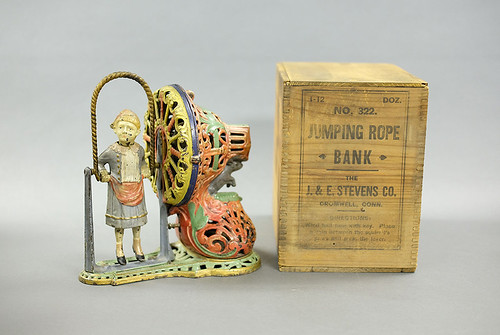
Over the weekend of June 2-3, 2018, RSL Auction Company will offer the collections of two legendary pioneers of the antique toy and bank hobby: Tom Sage Sr., and Dr. Gregory Zemenick – widely known in the trade as “Dr. Z.”
The Saturday session will begin at 10 a.m. with 175 cast-iron mechanical banks from the Sage collection. Then, following a short intermission, the spotlight will shine on Dr. Z’s 300-lot assemblage of mechanical, clockwork and early American tin toys; plus antique tobacciana and cast-iron novelties.
Sage’s Mikado bank, estimated at $120,000-$160,000, was acquired in the early 1990s at the storied John D. Meyers sale. “Mr. and Mrs. Meyers were old-time, first-generation bank collectors from Chicago. Their Mikado – which would become another of Tom’s prized possessions – is one of fewer than ten known to exist,” Haradin said.
Other great rarities in the Sage collection include a circa-1907 J. & E. Stevens Clown, Harlequin & Columbine bank in all original condition, estimate $90,000-$120,000; five color variations of the Mammy bank in pristine-plus condition; a superb Squirrel on Stump mechanical, a near-mint Two Frogs bank, and a pristine-plus Confederate-version Artillery Bank.
To read the complete article, see:
RSL to auction fabled antique banks and toys of Tom Sage Sr. and Dr. Z,
June 2-3 in New Jersey (http://artdaily.com/news/104373/RSL-to-auction-fabled-antique-banks-and-toys-of-Tom-Sage-Sr--and-Dr--Z--June-2-3-in-New-Jersey#.Wuz-uogvyAs)
Finders Keepers, Unless It's Your Job
The bars, each weighing 1kg (2.2 lbs), were wrapped in newspapers, and police suspect that their original owner threw them away in a hurry because he risked being caught.
Currently, there is no proof that the gold is connected to criminal activity. It was originally thought that the cleaner, who has not been named by the media, would be able to make a substantial claim on the goods.
However, the airport has said that the cleaner won't be able to receive any reward because they were "working as airport staff and it is a part of the cleaner's job to find lost things".
To read the complete article, see:
S Korean cleaner may lose out after finding gold in bin (http://www.bbc.com/news/blogs-news-from-elsewhere-43972394)
Son Finds Father's Buried Coins
An eight-coin 1876 Proof set containing silver and minor coinage, buried by its owner in the backyard of his Chicago home more than two decades ago, was brought for authentication and grading April 27 to the Central States Numismatic Society convention in Schaumburg, Illinois, by the late owner’s son.
The unusual story has a tragic element. The late collector, who died in 1994 at age 84, suffered with Alzheimer’s disease the last five years of his life, according to his son. The son said there’s a possibility that his father may have buried his entire extensive collection of United States coins. The coins, which have been off the market for more than 50 years, were primarily silver and gold issues.
To read the complete article, see:
Family finds holdered 1876 Proof set buried in yard
(https://www.coinworld.com/news/us-coins/2018/05/family-finds-1876-proof-set-buried-in-yard.all.html)
Mark Feld's Coin Collecting Tips
• Buy/collect what YOU like. But keep in mind that when it comes time to sell, not everyone else will necessarily like what you did/do.
• Don’t keep buying coins without ever selling any of them – learn what it’s like to try to sell, too. Once in a while you should offer one or two of your coins back to the dealers you acquired them from. See how they deal with that type of situation and whether they want to re-acquire those “gems” they sold to you.
• Don’t be afraid or embarrassed to ask lots of questions. You and just about everyone else can learn a great deal that way.
To read the complete article, see:
Mark Feld's coin collecting tips. (https://www.cointalk.com/threads/mark-felds-coin-collecting-tips.314990/)
DOC STOUFFER POEM: COINS
Every once in a while an interesting letter comes in the mail and I feel it needs some special attention; the following is one such example.
“Dear Editor,”
“Life takes some strange turns. My interest in coins began approximately 70 years ago and is still active. But at ages 91-92 something new! I’m writing poetry! I’ve never had one iota of interest in this topic before. I now write on subjects that to my knowledge few or no poets have used as subjects.
So naturally, I’ve written one on coins. I know Shakespeare mentioned coins in his plays (as a matter of fact I used to collect and exhibit them). But I know of no others who have used coins in a poem.
Can you believe this? A retired 92 year old dentist (Numismatist as well) writing poetry! I’ve dedicated my poem to our Red Rose Coin Club (Lancaster, PA). I thought your readers might enjoy it. Enclosed is a copy of “Coins”
Best Wishes for 2018
“Doc“ Stouffer
That all knowledge will never be past
We know they’re made of copper, silver, or gold
And of many other things I am told
When first studying a coins design
Very often you’ll see a favorite of mine
Yes, the bird of our nation – the eagle
Our sculptors have tried to make it look regal
To go back to the early coinage birth
The Greeks and Romans learned to value their worth
Please don’t judge a coin by its weight
And don’t always judge age by the date
Joined in the hobby is the medal and token
Many clubs and groups for them are well spoken
As to who forms a collection
Be sure to learn all possible protection
While learning of many a numismatic mystery
You’re sure to learn a great deal of history.
Dedicated to the Red Rose Coin Club
Editor:
Thanks “Doc” we appreciate your poem and we’re glad you are still active in your numismatic adventure and we wish you continued good health and good fortune in your numismatic journey!
This has been the third article since I took over the editorship of the Clarion, in May 2011, that “Doc” has sent in. I can only hope there are more stories like his out there to tell (and print). Thanks, Doc.
To read the earlier E-Sylum article, see:
NUMISMATIC POETS SOCIETY AWARD (http://www.coinbooks.org/v21/esylum_v21n16a22.html)
For more information on PAN and the upcoming show, see:
http://www.pancoins.org/

